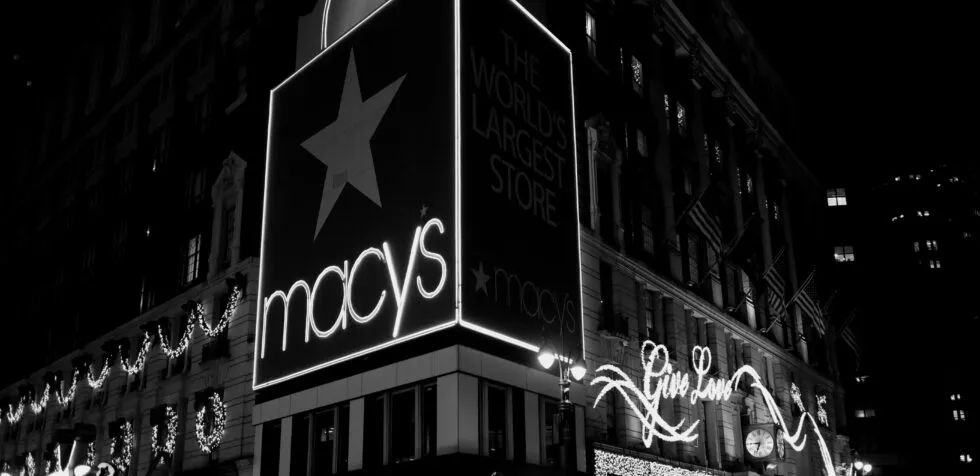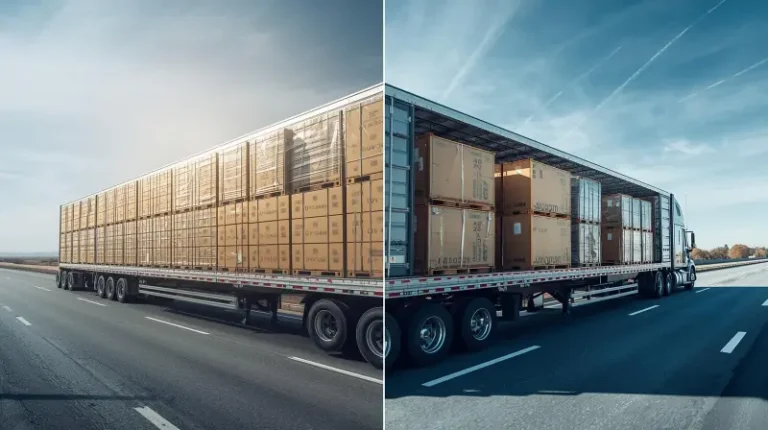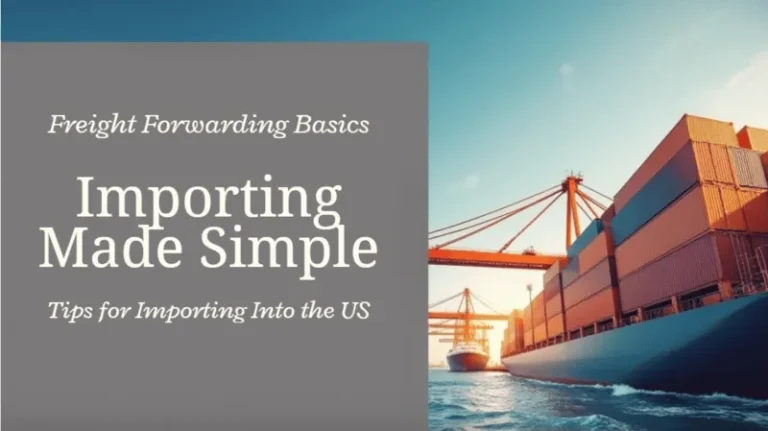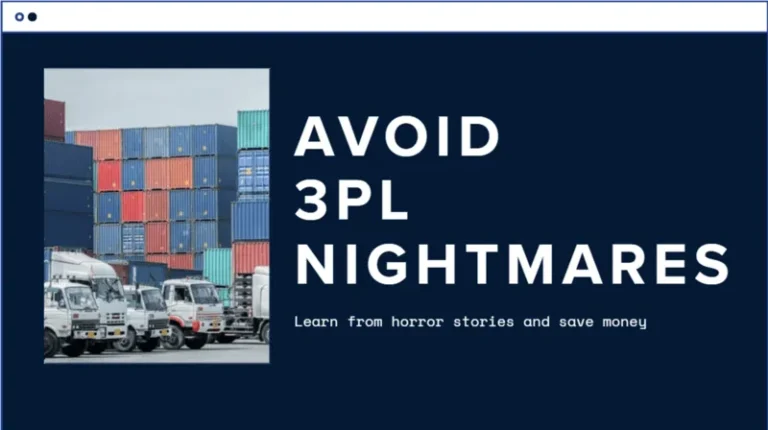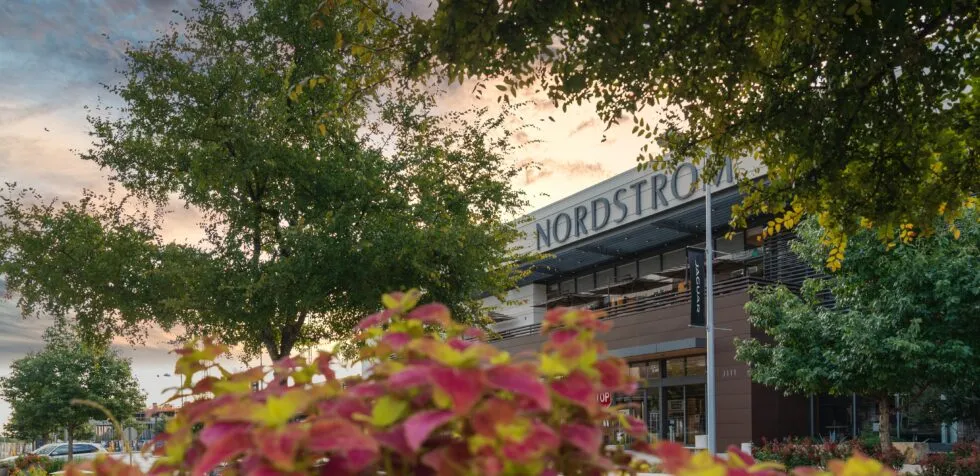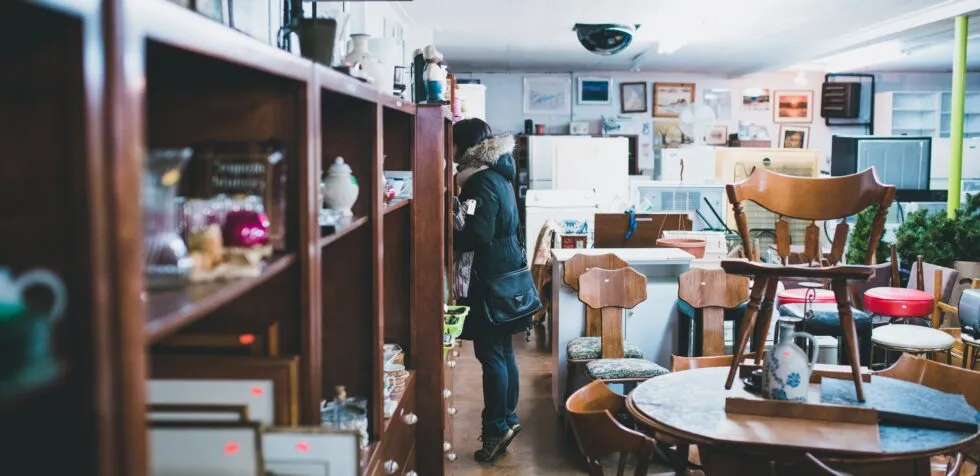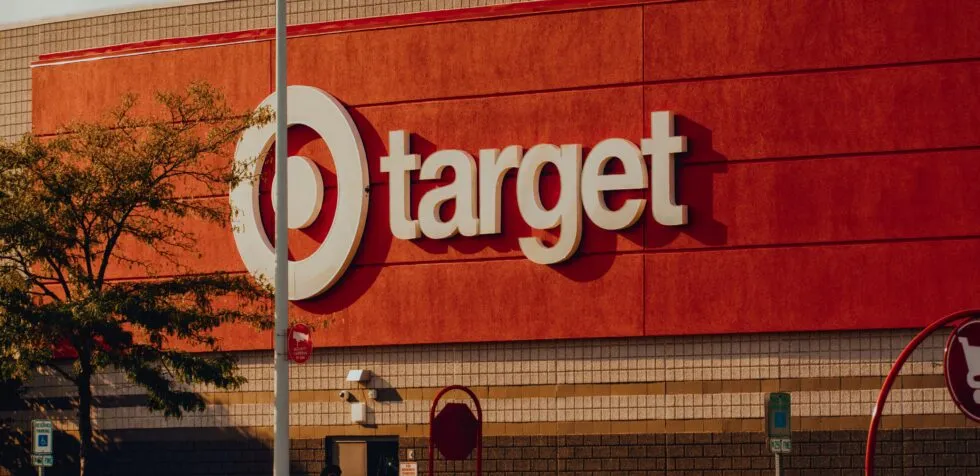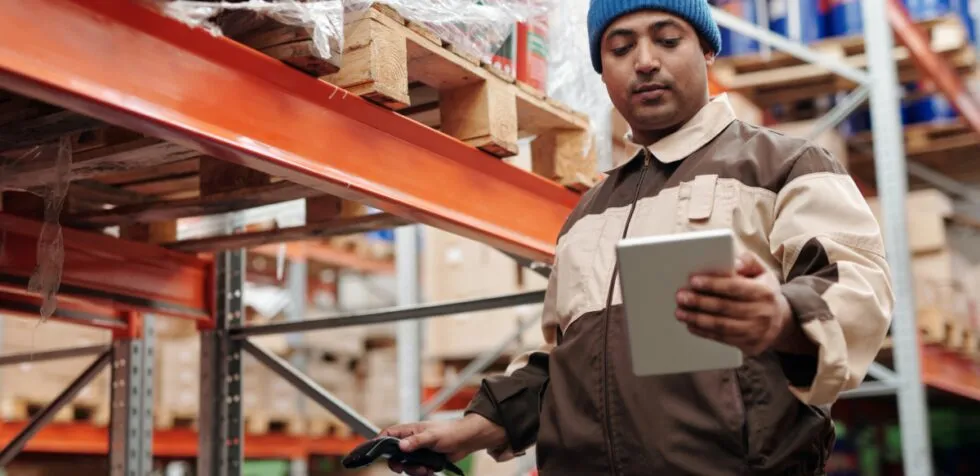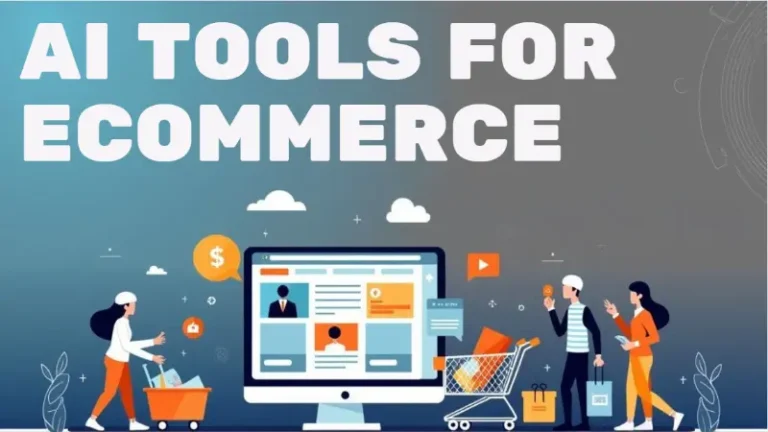Beauty Fulfillment & Cosmetics Services 3PL
The Health & Beauty industry is currently the fourth-largest retail category in the US and one of the fastest-growing consumer markets on the planet. Led by the Cosmetics and Skin Care categories, the industry has proven resilient, offering products that consumers just can’t get enough of.
Despite difficulties for brick-and-mortar retailers during the height of the Covid-19 pandemic, the industry is thriving online. According to a McKinsey report, the market for beauty products is expected to reach $580 billion in 2027, up from $430 billion in 2022, with that growth coming almost entirely from the online market. In fact, it’s growing more quickly than the overall ecommerce market, showing great promise as a place where sellers can earn big returns if they get things right.
That being said, getting things right in beauty products fulfillment is no easy task. From climate controls to hazardous goods to high damage rates, cosmetics (and other beauty products) present significant challenges.
In this article, we’ll provide an inside look into what you need to look for in a 3PL warehouse that will support your profitable growth as a Health & Beauty seller.
What is Cosmetics Fulfillment?
Cosmetics fulfillment refers to the process of storing, managing, and shipping beauty and cosmetics products to customers. This critical aspect of the beauty industry encompasses a range of services, including receiving and storing inventory, processing orders, picking and packing products, and shipping them to customers. Effective cosmetics fulfillment is essential for maintaining customer satisfaction and fostering brand loyalty. In an industry where product quality and timely delivery are paramount, a well-executed fulfillment process ensures that beauty and cosmetics products reach customers in perfect condition, enhancing their overall experience and trust in the brand.
Definition of Cosmetics Fulfillment Services
Cosmetics fulfillment services are specialized logistics solutions tailored to meet the unique needs of beauty and cosmetics products. These services typically include:
- Climate-Controlled Storage: Ensuring that products are stored in optimal conditions to maintain their quality and freshness.
- Secure Packaging: Using robust packaging methods to prevent damage and leakage during transit.
- Expedited Shipping: Offering fast shipping options to meet customer expectations for timely delivery.
- Inventory Management: Implementing precise tracking and timely restocking to ensure product availability.
- Order Fulfillment: Efficiently processing and shipping orders to customers.
These services are designed to handle the specific requirements of beauty and cosmetics products, ensuring that they arrive in perfect condition and delight customers.
Importance of Efficient Fulfillment in the Beauty Industry
Efficient fulfillment is crucial in the beauty industry, as it directly impacts customer satisfaction and brand loyalty. Beauty brands that can deliver high-quality products quickly and efficiently are more likely to build trust and loyalty with their customers. In contrast, delayed or damaged shipments can lead to negative reviews and lost sales. By prioritizing efficient fulfillment, beauty brands can enhance their reputation, increase customer satisfaction, and foster long-term brand loyalty.
Slash Your Fulfillment Costs by Up to 30%
Cut shipping expenses by 30% and boost profit with Cahoot's AI-optimized fulfillment services and modern tech —no overheads and no humans required!
I'm Interested in Saving Time and MoneyBenefits of Outsourcing Cosmetics Fulfillment
Outsourcing cosmetics fulfillment can bring numerous benefits to beauty brands, including:
- Cost Savings: Outsourcing fulfillment can help reduce labor and overhead costs associated with managing inventory and shipping products.
- Increased Efficiency: Specialized fulfillment providers can process orders and ship products more quickly and accurately than in-house teams.
- Scalability: Outsourcing fulfillment allows beauty brands to scale their business more easily, without having to invest in additional infrastructure and personnel.
By leveraging the expertise of specialized fulfillment providers, beauty brands can focus on their core business activities, such as product development and marketing, while ensuring that their logistics operations are handled efficiently and cost-effectively.
Scalable Services to Support Business Growth
Scalable fulfillment services are designed to support business growth by providing flexible and adaptable solutions that can adjust to changing demands. These services typically include:
- Flexible Inventory Management: Accommodating fluctuating demand to ensure product availability.
- Adjustable Shipping Options: Meeting changing customer expectations with a variety of shipping choices.
- Real-Time Tracking and Reporting: Monitoring inventory levels and shipping status to maintain transparency and control.
- Customized Packaging and Labeling: Enhancing brand image and customer experience with tailored packaging solutions.
- Reverse Logistics Handling: Facilitating a seamless returns process to minimize waste and optimize the consumer experience.
By outsourcing cosmetics fulfillment to a specialized provider, beauty brands can focus on their core business and leave the logistics to the experts. This can help improve customer satisfaction, increase brand loyalty, and drive business growth.
What You Need From Your Cosmetics 3PL
While there are many similarities between fulfilling online orders for Health & Beauty products and general consumer packaged goods, beauty products have special needs that many 3PL warehouses aren’t equipped to handle.
In this section, we’ll break down the added requirements that 3PLs need to excel in providing excellent beauty product order fulfillment.
Climate Controls For Beauty Product Fulfillment
One of the most important considerations when choosing an order fulfillment company is the type of climate conditions that your products will require. Certain types of cosmetics become damaged when they are stored in conditions that are too hot, cold, wet, or dry. Lipstick, some blushes, mascaras, cream-based shadows, and more can all melt when exposed to warm temperatures. Once these products reach a certain temperature, their consistency begins to change and may render the products unusable altogether.
Unfortunately, many 3PLs maintain warehouses at warmer temperatures in order to save money on air conditioning – which makes them too warm for cosmetics. And product loss in the warehouse isn’t even your biggest concern (though it’s enough to destroy an ecommerce business on its own). Even worse, your outsourced warehouse team likely won’t realize that products are damaged before they ship them out. That leads to a mass of customers all receiving damaged products at once, and when they take to social media to complain it will create a lasting negative impression of your brand.
Therefore, it’s critical that any 3PL warehouse that you choose is equipped to handle, store, and ship cosmetics in optimal climate conditions so that your customers are able to receive the very best version of your product.
A good rule of thumb is to ask your 3PL company whether they guarantee their warehouses at or close to room temperature. Since most cosmetics are designed to be stored in cool, dry conditions in a user’s vanity, they’re usually safe at 72 degrees. That being said, know your product! If it requires more precise heat regulation, then you need to be even more careful up-front with your 3PL.
Cahoot has a wide variety of temperature-controlled warehouses, perfect for storing sensitive goods such as cosmetics.
Looking for a New 3PL? Start with this Free RFP Template
Cut weeks off your selection process. Avoid pitfalls. Get the only 3PL RFP checklist built for ecommerce brands, absolutely free.
Get My Free 3PL RFPHazardous Goods Storage & Handling
Certain beauty products also have special requirements when it comes to safety and proper handling. In particular, many fragrances can create unsafe conditions and require specific treatment in storage. Many contain ethyl alcohol, which is flammable and puts them in hazard class 3.
Many 3PL warehouses avoid goods in hazard categories, as they either don’t want to take on extra risk or don’t have proper certifications for handling dangerous goods. Make sure that you’re up-front with the order fulfillment partners about the hazard classes that your goods fall into, or you risk wasting precious time and money sending them inventory that they legally can’t take.
We know that it can be hard to find a warehouse that not only accepts hazard class goods, but is built specifically for them. Cahoot ecommerce order fulfillment has intentionally curated warehouses with different specialties, including handling dangerous goods. We can go above and beyond to enable sellers with goods that have special handling needs.
Careful Packaging for Safe Shipping
One metric defines online seller profitability more than any other: customer lifetime value. With digital advertising becoming increasingly expensive, most sellers lose money on new customers. They’re only able to earn a positive bottom line through long-time repeat customers.
In Health & Beauty – perhaps more so than in any other industry – a fantastic post-purchase customer experience is critical to building repeat rates. Unfortunately, it’s more difficult to safely ship glass and fragile bottles than it is to ship other goods. So, the industry that most needs to minimize damage rates often has the hardest time doing so.
Unfortunately, many 3PLs that claim they can handle cosmetics and other beauty products treat them like any other good when it comes time to package them for shipping. This is insufficient: fragile items need extra time and care during packing.
Cahoot uses a combination of intelligent packing software and responsive customer service to get packaging right for the toughest goods to ship. We optimize for two things: we keep the package as small as possible to minimize shipping cost while also getting damage rates as close to 0% as possible. In this way, you save money on shipping while also ensuring that your customers are delighted when they open up their products every time.
Responsive Customer Service
Though responsive customer service is important for all online sellers, it’s especially important for a cosmetics 3PL given the above additional needs. As we’ve seen, Beauty & Health products have more unique shipping and handling needs, so you need to be able to get in touch with your 3PL’s customer service team quickly to feel confident that they know how to excel with your products.
Look for a 3PL company that offers you a real person to work with your account and multiple ways to get in touch with them. If it’s a small issue, live chat will do. Thornier challenges, on the other hand, should be governed by a detailed ticket system. And, of course, you need a phone line for critical issues.
Cahoot clients love our easy-to-reach and proactive customer service team. Our team is based in the USA, and they take the time to get to know your ecommerce business, so you don’t have to start at square one with a new person every time you submit a ticket. The close relationship we forge with our sellers is foundational to our ability to go above and beyond as a cosmetics 3PL.
Scale Faster with the World’s First Peer-to-Peer Fulfillment Network
Tap into a nationwide network of high-performance partner warehouses — expand capacity, cut shipping costs, and reach customers 1–2 days faster.
Explore Fulfillment NetworkCahoot: The Best Cosmetics 3PL
Cahoot’s order fulfillment service network is built for the rigors of modern ecommerce. We’ll help you level the playing field with marketplaces and delight your customers with a stellar, Amazon-like delivery experience – no matter where you sell. We have pre-built integrations with major marketplaces, shopping carts, and ecommerce platforms to fuel your multi-channel growth.
Our innovative peer-to-peer model sets us apart by enabling us to offer low-cost, fast fulfillment by design. We recruit top-tier ecommerce merchants with their own warehouses to join our network as order fulfillment partners, and then our intelligent shipping software and control team keeps the whole system connected and running efficiently. Since we’re unlocking excess fulfillment capacity that was lying idle, we’re able to offer lower costs.
Critically for Health & Beauty sellers with the special handling needs we outlined above, we have a wide variety of merchants fulfilling for others as part of our network. Unlike other 3PLs that are building cookie-cutter warehouses designed to store easy-to-fulfill goods, we have specialists in temperature-controlled fulfillment, hazmat, and more. Our flexibility is part of what distinguishes us and makes us the best choice for sellers seeking a reliable cosmetics 3PL.
If you’d like to find out how Cahoot can help your ecommerce business, please get in touch with us. We can’t wait to show you how beauty products order fulfillment was meant to be.
Frequently Asked Questions
How much do cosmetics and beauty fulfillment services cost?
Costs for cosmetics fulfillment vary, and depend on a number of factors. Package size and the specific packaging and storage requirements of a given product will influence fulfillment costs, whether fulfillment is handled in-house or utilizing 3PL services. Pricing for 3PLs will also depend on factors like order volume and the capacity and policies of the 3PL in question. For detailed, custom pricing options, it is best to engage directly with 3PLs to determine what solutions and savings they can provide.
What kinds of regulations govern cosmetics products in the United States?
While cosmetics products do not require approval from the Food and Drug Administration (FDA), they are regulated by that body. Ingredients, labeling, effective dates, and product warning labels are all regulated by the FDA. For information about regulations that may impact your products, consult the FDA website.
What factors should I consider when picking a 3PL partner for my cosmetics fulfillment?
Finding the best fulfillment partner for you requires balancing general and cosmetic-specific needs for your product. Pricing, specialized storage and packaging solutions, order volume, and available locations for fulfillment centers are all important considerations. To find out if Cahoot can help you optimize your fulfillment strategy, speak to a representative about our custom fulfillment solutions.

Turn Returns Into New Revenue

Related Blog Posts
How To Choose The Best Macy’s 3PL For Your Orders
In this article
 16 minutes
16 minutes
- Understanding 3PL and Macy’s Fulfillment Needs
- Why is The Macy’s Vendor Direct Program Great For Sellers
- What Should You Look For in Macy’s Fulfillment Services
- Experience Working With Macy’s Sellers
- The Role of Logistics in Customer Satisfaction
- Top Macy’s 3PL Companies
- Cahoot: The Best Macy’s 3PL
- Summary
- Frequently Asked Questions
The best ecommerce brands and Sellers are constantly looking for new sales channels to expand their footprint. Most people think of Macy’s and its sister brand Bloomingdale’s as retailers that are heavily focused on their brick-and-mortar stores and trail well behind the likes of Amazon in ecommerce. Therefore, they are likely not the first names that come to a merchant’s mind when they consider expanding beyond Amazon. However, in recent years, Macy’s has begun to catch on to the surge in ecommerce and realizes that it represents an opportunity through which it can boost sales and revive stalling growth.
In 2022, Macy’s reported it had around 45 million active shoppers, of which 29.1 million were Star Rewards members – a sizable audience for an online seller to target. In a bid to increase the product mix that it offers, the company launched its online third-party marketplace in late 2022. Unlike Amazon’s marketplace, where nearly anyone can start selling, Macy’s platform is curated. Macy’s platform facilitates ecommerce opportunities for vendors by allowing them to manage their inventory effectively and optimize their fulfillment processes. This could be done to ensure they serve their customers with the brands and products they think will most appeal to them. If you’re reading this, it probably means you’ve been selected by them to feature your assortment – congratulations!
One of the key benefits of this 3rd Party Marketplace is its Vendor Direct Program – which allows merchants to receive orders that customers place on Macy’s website, and fulfill those orders on their own. This offers significant advantages for a couple of reasons.
Slash Your Fulfillment Costs by Up to 30%
Cut shipping expenses by 30% and boost profit with Cahoot's AI-optimized fulfillment services and modern tech —no overheads and no humans required!
I'm Interested in Saving Time and MoneyUnderstanding 3PL and Macy’s Fulfillment Needs
What Is Third-Party Logistics (3PL)?
Third-party logistics (3PL) refers to the outsourcing of various logistics and supply chain functions to an external service provider. This can include services such as warehousing, transportation, inventory management, and order fulfillment. By leveraging the expertise and infrastructure of a 3PL provider, Macy’s vendors can delegate critical components like warehousing and order fulfillment, allowing them to focus on their core business. In essence, third-party logistics providers take on the heavy lifting of logistics, enabling Macy’s vendors to concentrate on what they do best – creating and selling great products.
Benefits of Outsourcing Macy’s Order Fulfillment
Outsourcing Macy’s order fulfillment can bring numerous benefits, including improved operational efficiency, increased customer satisfaction, and cost savings. By partnering with a 3PL provider, Macy’s vendors can tap into their expertise and technology, ensuring seamless integration with the Macy’s platform and efficient order processing. This means that orders are processed quickly and accurately, reducing the likelihood of errors and delays. Additionally, 3PL providers offer flexible and scalable fulfillment services, allowing Macy’s vendors to adapt to changing market demands and customer preferences. This flexibility is crucial in today’s fast-paced retail environment, where customer expectations are constantly shifting. By outsourcing fulfillment services, Macy’s vendors can ensure that they are always ready to meet these expectations, leading to higher customer satisfaction and loyalty.
Why is The Macy’s Vendor Direct Program Great For Sellers?
Simplified Inventory Management
As Macy’s allows Sellers to fulfill their orders independently, you do not need to send some of your inventory to a Macy’s warehouse. This is a welcome relief for Sellers who might already have sent some inventory to Fulfilled By Amazon (FBA) or Walmart Fulfillment Services (WFS), and are overwhelmed by keeping track of all these different marketplace-specific order fulfillment solutions. Macy’s allows you to manage your order fulfillment entirely on your own, just like you might be doing for your Shopify storefront, for example. This ensures that you don’t have to work with another logistics solution that is specific to a single sales channel.
Whatever The Logistics Setup, Everyone Has a Fair Chance
Amazon’s A10 algorithm for search rankings, as well as the Buy Box algorithm, both assign high preference to listings that are fulfilled by the company’s in-house FBA logistics network. Additionally, when delays or issues occur with FBA, Amazon faces no penalties – whereas Sellers fulfilling their own orders face severe penalties if they or the carriers they rely on make a mistake, including having their product listings suspended. With Macy’s, there is no such competing network that stacks the odds against you – everyone competes equally, and the brands with the best products who achieve the highest order fulfillment excellence will win.
While all this offers Sellers and their businesses operational and strategic advantages, the program still has high expectations from participating brands. Your choice of a 3rd Party Logistics Provider is a crucial factor in determining your success, and there are a few key factors to consider.
Looking for a New 3PL? Start with this Free RFP Template
Cut weeks off your selection process. Avoid pitfalls. Get the only 3PL RFP checklist built for ecommerce brands, absolutely free.
Get My Free 3PL RFPWhat Should You Look For in Macy’s Fulfillment Services?
Full Compliance With Macy’s Vendor Direct Fulfillment (VDF) Tech Stack
Macy’s requires that Sellers integrate with their platform via CommerceHub. Within 1 hour of a purchase order being made, Sellers must push acknowledgment to Macy’s via this integration. Also, the order must be shipped within 2 business days, and merchants must push confirmation that the order was fulfilled to Macy’s via this connection (with carrier tracking information). Your Macy’s 3PL fulfillment partner must be able to work with this configuration and ensure your orders are shipped on time. Collaborating with third-party logistics (3PL) providers allows you to streamline operations and improve customer satisfaction for Macy’s orders.
“Cahoot is very responsive and organized in all aspects. Everything is prepared to give anyone the best experience ever. They’re the right partner to help you accomplish your business purpose.”
~ Italian Food Online Store
Speak to a fulfillment expert
Flexibility to Work With Macy’s Carrier Accounts
Macy’s will provide you with a UPS account which must be used exclusively for fulfilling VDF orders. Your 3PL partner must be able to have the flexibility and agility in both their software and operations which supports Sellers bringing their own accounts.
Ultrafast Shipping

Macy’s requires that 98.5% of orders are shipped (leave the warehouse) in under 2 business days. However, the consumer expectation today is for fast, free shipping across every channel. Whether you operate from a single warehouse that you own or lease, or work with a traditional 3PL that only has 1 or 2 fulfillment centers, covering the entire country from a limited number of locations becomes extremely challenging. Additionally, with Macy’s carrier accounts, you can only pick from UPS SurePost or Ground services to fulfill orders. Imagine if your 3PL only has a California fulfillment center, but you have to ship orders to New York – customers will have to wait 4-5 business days to get their order in the era of ultrafast same or next-day delivery. With a platform like Cahoot, you can leverage a network of strategically located warehouses to place your inventory closer to your end customers and shorten delivery speeds.
Adherence to Macy’s Packing Requirements
The little things are often the most important; merchants are required to place a Macy’s branded packing slip inside every carton shipped to customers. You need a fulfillment partner that is fully aware of all these requirements and will sweat the details to ensure you are compliant with all aspects of the VDF program.
Responsive and Reliable Customer Support

As part of the VDF program, Macy’s audits and reviews the performance of Sellers in the program – any mistakes or errors that your 3PL commits directly affect your brand reputation, the Macy’s customer experience, and your ability to remain an approved vendor. It becomes essential to have a customer support team that is responsive and ready to quickly resolve any issues that you may run into.
Experience Working With Macy’s Sellers
As we mentioned before, Macy’s marketplace is curated – meaning that it’s exclusive and there are not a large number of brands or Sellers approved to participate, unlike Amazon. This therefore means there are a limited number of order fulfillment services out there that have experience working with merchants who are part of Macy Vendor Direct. Make sure to identify a company that has demonstrable social proof of its track record supporting Macy’s merchants. Here’s what one of our customers, Glo International, had to say about their experience shipping Macy’s orders with Cahoot:
“Cahoot allowed us to reduce the monthly shipping cost and the support service is really responsive and efficient!”
~ Glo International
Speak to a fulfillment expert
The Role of Logistics in Customer Satisfaction
Effective logistics and fulfillment processes are the central components to achieving success in the Macy’s marketplace. When customers place an order, they expect it to be delivered accurately and on time. Any delays or errors in the fulfillment process can lead to dissatisfaction and potentially harm the brand’s reputation and ability to continue in the VDF program. By working with a reliable 3PL provider, Macy’s vendors can ensure that their warehousing and order fulfillment processes are optimized for speed and accuracy, prioritizing early shipment and delivery wherever possible (what cahoot calls ‘preponing’, the opposite of postponing). A well-executed logistics strategy will not only meet but exceed your customer’s expectations, leading to repeat business and greater lifetime customer value.
Top Macy’s 3PL Companies
Amazon Multi-Channel Fulfillment
Amazon Multi-Channel Fulfillment (MCF) is Amazon’s outsourced fulfillment service for merchants selling on non-Amazon sales channels, such as Macy’s, whereby Amazon handles the picking, packing, and shipping of the orders coming from those sales channels. Ecommerce Sellers can store their inventory at Amazon’s warehouses, and MCF will fulfill the non-Amazon orders from select channels.
ShipBob
ShipBob is a 3PL that focuses on serving ecommerce merchants. They have a nationwide network of order fulfillment centers that enable fast shipping, but they charge extra for guaranteed 2-day shipping. Built for ecommerce, they have an easy-to-use shipping software platform and a large set of pre-built integrations.
Cahoot: The Best Macy’s 3PL
Cahoot’s order fulfillment network is built for the future of ecommerce. Our network of warehouses is strategically located at different locations in the US, enabling Macy’s merchants to offer ultrafast shipping. Our fulfillment centers are well equipped to handle all types of SKUs (including the ones that the typical Amazon fulfillment center may struggle to process) – small, lightweight, seasonal, slow-moving, heavy, and oversized.
We are also fully compliant with the Macy’s technology and packing requirements – and provide you the flexibility to use the Macy’s UPS account provided to you without any hidden fees. Lastly, our US-based customer service team is always available if something needs to be addressed, ensuring that sales are uninterrupted and that you enjoy a successful partnership with Macy’s.
|
|
 |
Traditional 3PL |
|---|---|---|
|
Compliant with Macy VDF Tech Stack |
|
|
|
Flexibility to use Macy’s UPS account |
|
|
|
Ultrafast nationwide shipping |
|
|
|
Great Customer Support |
|
|
Cahoot is committed to helping Macy’s Sellers grow their businesses with fast and affordable ecommerce order fulfillment service.
Scale Faster with the World’s First Peer-to-Peer Fulfillment Network
Tap into a nationwide network of high-performance partner warehouses — expand capacity, cut shipping costs, and reach customers 1–2 days faster.
Explore Fulfillment NetworkSummary
Macy’s Vendor Direct (often called Macy’s Marketplace) is Macy’s curated third-party marketplace. Launched in Fall 2022 (powered by Mirakl), it allows external sellers to list on Macy’s website and ship directly to customers. Macy’s has aggressively grown this channel to fill assortment gaps without inventory risk. At launch (Sep 2022), the marketplace gave customers access to 400 brands across 20 categories, many new to Macy’s. A Mirakl case study notes that Macy’s “added 2,000+ brands” via the new marketplace, with digital marketplace sales spiking 145% quarter-over-quarter in FY 2023. By late 2023, Macy’s reported 2,300+ brands active on its platform (the effort continues under its “A Bold New Chapter” strategy). In mid-2023, Macy’s also opened a Bloomingdale’s Marketplace (a circuit of Macy’s higher-end brand), which onboarded ~120 sellers by year-end. The company continues to invest: expanding the marketplace assortment and even integrating some products into stores, demonstrating that its marketplace has become a major growth vector.
Macy’s marketplace is invite-only/approval-only. Sellers must be vetted for brand fit and logistical readiness. The program is similar to Nordstrom’s drop-ship (Macy’s calls it Vendor Direct Fulfillment), but uses a marketplace billing model: Macy’s pays sellers after the sale (minus commission). Notably, Macy’s includes marketplace items in its Star Rewards loyalty program, incentivizing customers to buy. Sellers get access to Macy’s marketing and promotional events once active.
Table 1. Summary of the Macy’s Vendor Direct Program Requirements
|
Requirement
|
Details
|
|---|---|
|
Fees
|
No setup or monthly fees. Commission: Varies by category, typically ~15% of the sale price.
|
|
Payment Terms
|
Paid twice-monthly (the 1st and 15th of each month) for approved invoices.
|
|
Application
|
Invite-only (curated). Macy’s onboards sellers through its merchant recruitment team. Prospective sellers must meet strict brand/quality standards; selling unrelated or low-end items is unlikely to be approved.
|
|
Integration
|
Mirakl marketplace platform (via Mirakl Connect or a ChannelEngine-like partner) for catalog, plus EDI (CommerceHub) for orders/invoices. (Macy’s requires an EDI* or CommerceHub connection for order fulfillment.) Sellers must use a U.S. return address and handle all sales tax/W-9 requirements.
|
|
Shipping SLA
|
Ship complete orders within 2 business days of receiving the Macy’s PO. (Vendors must cancel any order not shipped by day 2.) Failing to ship/cancel on time can lead to cancellation. Macy’s provides a prepaid UPS account; vendors must bill all shipments to Macy’s UPS account (Ground Saver). Third-party or incorrect accounts can cause expense offsets.
|
|
Return Handling
|
Vendors accept returns directly from customers. If a customer returns an item (mail or store), the vendor must confirm receipt/return to Macy’s within 2 business days. Macy’s then credits the customer (vendors are debited the order amount). Defective or wrong-item returns may be sent directly back to the vendor (with a charge-back). Vendors must pay for return shipping.
|
|
Other Expectations
|
All shipments must include Macy’s-branded packing lists and reference numbers. Vendors must not substitute items (strict item match). Orders must ship with no aftermarket UPCs and weigh under 150 lbs. Vendors must comply with Macy’s cost-change and invoice protocols (provide Macy’s PO number on invoices). Performance is monitored monthly against on-time shipping and cancellation benchmarks; failing vendors may be suspended.
|
Invitation and Onboarding Process
Macy’s invites vendors through merchant outreach. There is no public signup form; interested sellers typically contact the Macy’s merchant team or go through a partner (e.g., an ecommerce consultant). Once engaged, Macy’s provides the Vendor Direct Fulfillment (VDF) Agreement and technical specs. Onboarding involves setting up EDI/CommerceHub for receiving orders (Macy’s sends 850 POs) and sending ASNs (856) and invoices (810). Vendors must configure Macy’s UPS account (to bill Macy’s prepaid account) and submit W-9/tax info. Mirakl is used for catalog management; vendors upload product data with Macy’s taxonomy and await SKU approval. Initial authorization is granular by category; most sellers start with a few core categories. In practice, onboarding took a few months for initial sellers: a Deloitte report noted that at launch, Macy’s marketplace offered 400 brands in 20 categories (including eight new-to-Macy’s categories). After system setup and trial orders (Macy’s often does sample orders), the vendor goes live and begins shipping real customer orders.
Common Fulfillment Pitfalls
Even established vendors can struggle with Macy’s strict requirements. Common errors include late shipments and poor PO/invoice handling. For example, if a vendor does not ship (or cancels) within 2 days, Macy’s sends a late notice and may cancel the order if unaddressed. Some vendors incur expense offsets by accidentally using a non-Macy’s UPS account. Another frequent mistake is improper labeling: every carton must contain Macy’s-branded packing slips with both order and shipment numbers; failure to include these details complicates tracking and delays payment. Returns also cause issues: vendors sometimes forget to confirm returns within 2 days, delaying customer refunds.
Support Tip: Use a partner or software with built-in Macy’s compliance, such as Cahoot. A CommerceHub or Mirakl integration will automatically generate correct packing slips and transmit PO/ASN. Establish a daily routine to check Macy’s order portal and email alerts (Macy’s sends automated notices if any EDI response is missing). Maintain inventory accuracy to avoid cancellations, and process returns quickly.
If you’d like to find out how Cahoot can help your ecommerce business, please get in touch with us. We can’t wait to show you how Macy’s order fulfillment was meant to be.

If you are selling on multiple sales channels and are interested in a 3PL that can help you with fulfillment, check out some of our other articles:
- How to Choose the Best 3PL for Your Shopify Store
- How to Choose the Best 3PL for Wayfair
- How to Choose the Best 3PL for Target Plus
- How to Choose the Best 3PL for the Nordstrom Direct Drop Ship Program
Frequently Asked Questions
What carrier does Macy’s use for shipping?
The company uses UPS and the U.S. Postal Service to deliver packages, in addition to DoorDash for same-day delivery.
What is 3PL in retail?
3PL stands for third-party logistics, also known as order fulfillment. A 3PL warehouse provides a full range of ecommerce fulfillment services, including storage, order processing, shipping, and receiving. Many 3PL warehouses provide value-added services such as returns processing, cross docking, or kitting.
How many distribution centers does Macy’s have?
Macy’s currently operates 25 fulfillment centers across the U.S. Most recently, the retailer opened a new 908,000-square-foot distribution center in Tomball, Texas in September 2023, before leasing a 272,000-square-foot facility in Lathrop, Calif. in January 2024.
What is Macy’s biggest competitor?
The main competitors of Macy’s include Dillard’s (DDS), Nordstrom (JWN), Kohl’s (KSS), JC Penney, Burlington Stores (BURL), and Target (TGT).

Turn Returns Into New Revenue

How To Choose The Best Nordstrom 3PL For Your Orders | Cahoot
In this article
 19 minutes
19 minutes
- Why is the Direct Drop Ship Program Great?
- Understanding Nordstrom’s Requirements
- What Should You Look for in a Nordstrom 3PL?
- Benefits of Working with a 3PL
- Responsive, Reliable Customer Support
- Top Nordstrom 3PL Companies
- Cahoot: The Best Nordstrom 3PL
- Bringing Cherished Stories to Life
- Summary
- Frequently Asked Questions
Nordstrom is one of the most iconic department stores in the US. Nordstrom has over 9 million shoppers each year. For most people, the first thing that comes to mind when they think of Nordstrom are its brick and mortar stores. The company serves American customers through its over 350 locations. Most ecommerce sellers might therefore ignore the retailer in pursuit of players with a larger digital presence, such as Amazon or Walmart. However, online is becoming an increasingly important part of Nordstrom’s operations – according to Statista, each year since 2020 over 35%+ of Nordstrom’s annual sales were driven through digital channels.
Nordstrom’s Direct Drop Ship program is a way for sellers to access this large segment of shoppers. Through the program, sellers can feature their product assortment on Nordstrom’s website. When customers place orders on Nordstrom, merchants must pick, pack and ship the products either from their own warehouse, or through a 3rd Party Logistics Provider (3PL) to the customer.
Before we dive into how and why you can find this 3PL partner, it’s worth asking an important question – why is the program worth doing?
Why is the Direct Drop Ship Program Great?
Nordstrom’s Direct Drop Ship Program has several powerful benefits for participating sellers:
Invite-only Marketplace Where You Can Grow Sales
Nordstrom’s Direct Drop Ship program is currently invite only – like the 3rd party marketplaces at Macy’s and Target. Nordstrom may be doing this to simplify the product assortment customers see, making it easier for them to find things they really like. For sellers, this is great because it provides access to Nordstrom customers with much less competition compared to a sales channel like Amazon, where nearly anyone can sell.
Nordstrom Provides Full Assistance With EDI Integration
Nordstrom requires transmission of information between themselves and their sellers through Electronic Data Interchange (EDI). The company does this through a CommerceHub platform called DropShip Commerce (DSCO). Whenever purchase orders are received, Nordstrom will transmit the information via EDI to the seller. Similarly, sellers must pass updates from their side (acknowledgements of Purchase Orders, Advance Shipment Notifications with tracking information etc.) through the DSCO platform.
Some retailers require the seller to take care of configuring this technology on their dropshipping programs. Nordstrom provides both the platform and assistance in integrating it with their systems.
Nordstrom Covers All Shipping Costs
One of the great advantages of the program is that shipping fees are paid for by Nordstrom. While other elements of order fulfillment, such as packaging and storage fees are still the responsibility of the seller, shipping labels are a significant cost that Nordstrom takes off their shoulders.
Sellers must make sure that they use the UPS billing account that Nordstrom provides them – so long as merchants comply with this, they will be reimbursed shipping costs across a variety of services – including Ground, 3 Day Select, 2nd Day Air and Next Day Air Saver.
Slash Your Fulfillment Costs by Up to 30%
Cut shipping expenses by 30% and boost profit with Cahoot's AI-optimized fulfillment services and modern tech —no overheads and no humans required!
I'm Interested in Saving Time and MoneyUnderstanding Nordstrom’s Requirements
Nordstrom has specific requirements for its trading partners, including EDI compliance, timely order fulfillment, and accurate inventory management. To ensure a smooth partnership, it’s essential to understand these requirements and implement them effectively.
Trading Partner Requirements
As a trading partner with Nordstrom, you’ll need to meet certain requirements, such as:
- Timely Order Fulfillment: Nordstrom expects its trading partners to fulfill orders promptly and accurately, ensuring that customers receive their products on time. Meeting these expectations is crucial for maintaining customer satisfaction and upholding Nordstrom’s reputation for reliability.
- Accurate Inventory Management: Trading partners must maintain accurate inventory levels to prevent stockouts and overstocking. Proper inventory management helps ensure that products are always available for purchase, which is vital for keeping customers happy and maintaining a smooth supply chain.
- EDI Compliance: Nordstrom requires its trading partners to be EDI-capable, which involves exchanging electronic documents, such as purchase orders and invoices, in a standardized format. This ensures seamless communication and data exchange between Nordstrom and its partners, reducing errors and improving efficiency.
Integration Options
To integrate with Nordstrom’s systems, you’ll need to consider the following options:
Integrate with Ecommerce Platforms
Nordstrom requires its trading partners to integrate with its ecommerce platform, which involves connecting your online store to Nordstrom’s system. This integration enables you to:
- Receive Purchase Orders Electronically: By integrating with Nordstrom’s ecommerce platform, you can receive purchase orders directly into your system, streamlining the order processing workflow and reducing manual data entry.
- Send Shipment Notifications and Tracking Information: Integration allows you to send shipment notifications and tracking information to Nordstrom automatically. This ensures that customers are kept informed about the status of their orders, enhancing their shopping experience.
- Update Inventory Levels in Real-Time: Real-time inventory updates help you maintain accurate stock levels, preventing overselling and stockouts. This integration ensures that Nordstrom always has up-to-date information about your inventory, which is crucial for maintaining a smooth supply chain.
By integrating with Nordstrom’s ecommerce platform, you can improve the efficiency of your order fulfillment process and ensure that you meet Nordstrom’s requirements. This seamless connection helps you provide a better customer experience and maintain a strong partnership with Nordstrom.
What Should You Look for in a Nordstrom 3PL?
Due to Nordstrom’s stringent requirements, many sellers find it simpler and more profitable to rely on an established 3PL that is already familiar with and comfortable meeting Nordstrom’s requirements. This way sellers can reap the benefits of participating in Nordstrom’s Direct Drop Ship program without having to completely retool their inventory storage and order workflows.
Maintain a Fulfillment Rate of 98%

Nordstrom requires that sellers keep cancellations extremely low – 98% of orders must be fulfilled before the defined due date on the DSCO system.
Traditional 3PLs that operate with a single warehouse location may not be ideal – in the event of any disruption at that location (extreme weather, carrier services disruption etc.), your ability to ship products on time to customers will be impacted.
Additionally, traditional 3PLs may be limited to basic spreadsheets or worse, manual bookkeeping to keep track of your inventory. If you run out of stock and purchase orders continue flowing in, you will be forced to cancel them, affecting your fulfillment rate metrics. Cahoot’s software intelligently decrements the count of inventory as it leaves our warehouses and provides color-coded alerts to you on a dashboard so that you always replenish products in time to keep your sales going.
Ability to Ship 97% of Orders On-Time
Nordstrom defines its shipping SLAs based on whether the order requires Standard or Expedited Shipping.
Achieving this high level of performance comes down to ensuring that your fulfillment partner has excellent pick/pack and order fulfillment practices to get every order out within time.
Make sure to conduct extensive research into the standards at your 3PL’s warehouse. On Cahoot’s order fulfillment network, warehouses must pass a 44-point checklist to be eligible to fulfill orders for our sellers.
|
Level of Service |
SLA for Shipping |
|---|---|
|
Ground |
1 business day |
|
3 Day Select |
1 business day |
|
2nd Day Air (PO received before 12 PM PST) |
Same Day |
|
2nd Day Air (PO Received after 12 PM PST) |
1 business day |
|
Next Day Air Saver (PO received before 12 PM PST) |
Same Day |
|
Next Day Air Saver (PO received after 12 PM PST) |
1 business day |
“The Cahoot team have been great to work with — always trying to provide great service and address any concerns and issues quickly and effectively. We’ve been very impressed with their shipping performance and communication on status of delivery for packages.”
~ Fenix Light Store
Speak to a fulfillment expert
Have an Existing UPS Account, and Experience Working With the Carrier
Nordstrom requires that sellers ship all Nordstrom orders on their own UPS account, which is connected to your, or your 3PL’s UPS account. In order to meet Nordstrom’s fulfillment metrics, your 3PL must have experience working with UPS to ensure that daily pickups and carrier scans are conducted in a timely fashion, thereby streamlining your Nordstrom order fulfillment.
Help You Meet Nordstrom’s Eco-Friendly Packaging Standards
In Nordstrom’s words, they ‘strive to be an environmentally friendly company’. They also encourage sellers to avoid excess packaging.
With many traditional 3PLs, you may find that items often ship in boxes larger than the SKU actually needs. The problem is that most traditional 3PLs have a very limited configuration of boxes of standard sizes. Items are simply thrown into the next available box, without taking care to identify if it is truly the most optimal one.
The problem worsens with Multi-Line, Multi-Quantity (MLMQ) Orders. These orders can often be unnecessarily split into multiple boxes. With Cahoot’s MLMQ automation features, our system learns from SKU and box dimension data, as well as past data to intelligently identify the most optimal box for every order.
This ensures that you save costs across every order, while also meeting Nordstrom’s (and the customer’s) expectation for more environmentally responsible, sustainable packaging.
Fully Compliant With Nordstrom Packing Slip Requirements
Nordstrom requires every shipment sent to customers to have a branded packing slip, as well as a return label (Nordstrom bears all shipping costs).
This is an example of what a Nordstrom packing slip looks like:

This is what a Nordstrom return label looks like:
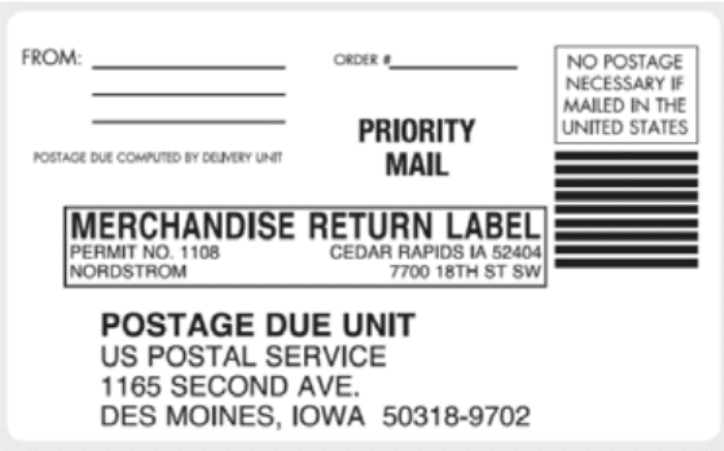
Your 3PL fulfillment partner must sweat the details and ensure that all of these requirements are complied with – the little things matter enormously toward ensuring both continued enrollment in the Direct Drop Ship program, as well as customer satisfaction.
Fully Compliant with Nordstrom EDI Technology
The 3PL must be able to work with the Direct Drop Ship Program’s tech stack (DSCO platform) and ensure that you comply with all the requirements around data transmission to Nordstrom.
Benefits of Working with a 3PL
Working with a third-party logistics (3PL) provider can help you meet Nordstrom’s requirements and improve your overall business operations. Some benefits of working with a 3PL include:
- Improved Order Fulfillment: 3PLs specialize in order fulfillment and can help you meet Nordstrom’s timely fulfillment requirements. Their expertise in logistics ensures that orders are processed and shipped efficiently, reducing the risk of delays and errors.
- Enhanced Inventory Management: 3PLs can help you manage your inventory levels more effectively, reducing the risk of stockouts and overstocking. With advanced inventory management systems, 3PLs provide real-time visibility into your stock levels, helping you make informed decisions about replenishment and stock allocation.
- Increased Efficiency: 3PLs can streamline your logistics operations, freeing up time and resources for you to focus on growing your business. By outsourcing logistics to a 3PL, you can concentrate on core business activities such as marketing, product development, and customer service.
Responsive, Reliable Customer Support

Order fulfillment is a complex operation, involving multiple, intricate steps in the process from click to delivery. Things don’t always go as planned, but what is crucial is ensuring that your 3PL has a responsive, reliable customer support team whom you can rely on to fix problems fast, with minimal disruption to your business operations.
Experience Working with Nordstrom Sellers
Most traditional 3PLs may not have personnel with the experience and expertise working with Nordstrom to troubleshoot and fix problems fast – costing you precious time and sales. It is important to identify a Nordstrom fulfillment partner with a reliable, responsive customer support team – who will be ready to dive in and solve problems quickly, so that you’re always selling and keeping your customers happy.
Here’s what one of our customers had to say about Cahoot’s Support team:
Cahoot’s support is prompt and personal, not monolithic and apathetic as some large companies tend to be. Cahoot is not only a great 3PL provider but also a strategic partner that goes above and beyond for its clients. They are a 5-star team of people who make it their business to care about yours.”
~ VERSACART
Speak to a fulfillment expert
So now that we’ve taken a look at the important criteria that guide your choice of a 3PL for Nordstrom, let’s look at the options that are actually available to you, and the pros and cons of each of them:
Top Nordstrom 3PL Companies
Amazon Multi-Channel Fulfillment
Amazon Multi-Channel Fulfillment (MCF) is Amazon’s outsourced fulfillment service for merchants selling on non-Amazon sales channels, such as Nordstrom, whereby Amazon handles the picking, packing, and shipping of the orders coming from those sales channels.
Ecommerce sellers can store their inventory at Amazon’s warehouses, and MCF will fulfill the non-Amazon orders from select channels. MCF deploys the same infrastructure and resources that power Amazon’s in-house Fulfilled By Amazon (FBA) logistics network.
ShipBob
ShipBob is a 3PL that focuses on serving ecommerce merchants. They have a nationwide network of order fulfillment centers that enable fast shipping, but they charge extra for guaranteed 2-day shipping. Built for ecommerce, they have an easy-to-use shipping software platform and a large set of pre-built integrations.
Cahoot: The Best Nordstrom 3PL
Cahoot is committed to helping Nordstrom sellers grow their businesses with fast and affordable ecommerce order fulfillment services.
Cahoot’s peer-to-peer order fulfillment network is built for the future of ecommerce. Our network of warehouses is located at strategic locations across the US, enabling Nordstrom Direct Drop Ship merchants to offer their customers ultrafast shipping. Our fulfillment centers are well equipped to handle all types of SKUs (including the ones that the typical Amazon Fulfillment Center may struggle to process) – small, lightweight, seasonal, slow-moving, heavy, and oversized.
We are compliant with all aspects of the Nordstrom Direct Drop Ship program – and provide you the flexibility to use the Nordstrom UPS account provided to you without any hidden fees. Our US-based customer service team is always available if something needs to be addressed, ensuring that sales are uninterrupted and that you enjoy a successful partnership with Nordstrom.
Bringing Cherished Stories to Life
Growth is a good problem to have – but how do you make sure it doesn’t bury you?
Cali’s Books creates and sells innovative children’s books that bring stories to life with interactive sounds and songs. What started as a dedicated mom working out of her garage has grown to an organization of colleagues around the world producing hundreds of unique books and fulfilling tens of thousands of orders each month.
Cali’s growth has taken off in diverse channels: Amazon, their Shopify store, and retailers like Nordstrom. Before Cahoot, they relied on a complex fulfillment strategy with multiple different partners to try to fulfill orders across their different channels.
Looking for a New 3PL? Start with this Free RFP Template
Cut weeks off your selection process. Avoid pitfalls. Get the only 3PL RFP checklist built for ecommerce brands, absolutely free.
Get My Free 3PL RFPSummary
Nordstrom’s Direct Drop Ship program is an invite-only channel that lets select vendors list products on Nordstrom.com and ship directly to customers. It is highly curated and supported; vendors need strong brand fit and logistics to qualify.
Table 1. Summary of the Nordstrom Drop Ship Program Requirements
|
Requirement
|
Details
|
|---|---|
|
Fees & Commissions
|
No setup, listing or transaction fees. Vendors sell to Nordstrom at wholesale cost (Nordstrom retains retail margin), so there is no marketplace commission per se.
|
|
Application
|
Invite-only – Nordstrom buyers hand-pick brands and expand the assortment carefully. There is no open signup; sellers typically enter via buyer relationships or referrals. (Historical notes suggest Nordstrom holds kickoff calls once invited.)
|
|
Technical Integration
|
Mandatory EDI/API via Dsco (e.g., CommerceHub DropShip Commerce). Nordstrom provides the DSCO platform and assists with setup. Vendors must connect inventory and orders via EDI/CSV/XML through DSCO. (No published public API.)
|
|
Order SLAs
|
Ship within 1 business day of order (orders placed by noon PST should ship same day; others by next day). Vendors must confirm shipment and invoice (via DSCO) on the ship date (within 1 day). Nordstrom pays UPS Ground/2nd Day Air; use Nordstrom’s UPS account. Nordstrom imposes no late-shipment or cancellation fees provided the vendor cancels in time.
|
|
Return Handling
|
All customer returns go to Nordstrom’s fulfillment center (Cedar Rapids) and are processed by Nordstrom. Vendors must accept returns of resalable and defective merchandise and issue credit invoices to Nordstrom. Vendors may apply a restocking fee (up to ~$2.50 per item) for resalable returns. Defects are handled per Nordstrom agreements (or case-by-case).
|
|
Other Ops Expectations
|
Unbranded packaging/labels only; no marketing inserts. Vendors must have a dedicated customer support line during North American business hours (Nordstrom Drop Ship Ops, M–F 9 am–5 pm PST). Gift-wrap or Nordstrom-branded packaging is optional (Nordstrom pays only carrier shipping).
|
Invitation and Onboarding Process
Nordstrom does not accept unsolicited sign-ups: new sellers join only by invitation from the Nordstrom buying team or merchant development group. Ideal candidates have strong brand recognition or a unique assortment that fits Nordstrom’s curation. In practice, Nordstrom will meet with a vendor (or 3PL) to review operations and the catalog. Once invited, the vendor signs a drop-ship agreement, provides required documents (U.S. business tax ID, W-9, etc.), and connects via the provided DSCO (CommerceHub) account. Nordstrom supports vendors through the EDI onboarding (often via a 3PL or system integrator). After DSCO integration, vendors load item data (UPC-based inventory), learn Nordstrom’s fulfillment requirements, and gradually activate SKUs on the site. The approval timeline is vendor-specific, but DSCO integration and system validation typically take 4–12 weeks for a completed setup.
Public accounts are scarce, but industry reports highlight Nordstrom’s emphasis on quality and its flexible integration. For example, Nordstrom adopted the Dsco/CommerceHub platform to streamline onboarding – one case study noted an onboarding rate of ~40 vendors/month (a 4× productivity increase) once DSCO was in place. Retail sources confirm Nordstrom covers all shipping fees (so sellers ship via Nordstrom’s UPS account) and imposes no late-shipment penalties.
Growth (2022–2025)
Nordstrom’s drop-ship channel remains much smaller than Amazon’s or Walmart’s. The company does not publicly report vendor counts. However, insiders note steady growth: by using DSCO, Nordstrom accelerated onboarding (one report cited a 4× increase in speed). Nordstrom executives have said drop-ship suppliers tend to increase overall buying from vendors rather than cannibalize sales. In practice, Nordstrom carefully adds only dozens of new vendors per year to keep the assortment curated. In summary, while Nordstrom’s digital sales are growing (>35% of sales online), the invite-only drop-ship program has expanded cautiously, focusing on apparel, shoes, and home categories without rampant expansion.
Common Fulfillment Pitfalls
New Nordstrom drop-shippers often falter on timeliness and compliance. Failing to ship within 1 day or to cancel unshippable orders promptly will lead to order cancellations (Nordstrom will cancel and not pay for late shipments). Other common issues include using the wrong shipping account (vendors must use Nordstrom’s UPS account to get paid), submitting invoices late, or incorrectly mapping items (SKU mismatches lead to payment delays). Vendors must carefully follow Nordstrom’s SKU/UPC data requirements and DSCO transaction formats. Return handling can also trip up sellers as Nordstrom only provides a single Return Authorization (RA) number for drop-ship returns, so vendors should have processes to handle returns without individual RAs.
Support Tip: Integrate with Nordstrom’s DSCO early and engage Nordstrom Drop Ship Operations if any order goes awry. Confirm all POs via DSCO (997 EDI) and ship notices quickly. Keep a live point of contact with Nordstrom’s team during onboarding. Some sellers have found that working through Nordstrom-approved 3PL partners (like Cahoot) simplifies DSCO integration and ensures compliance with Nordstrom’s gift-wrap and packing requirements. If you’d like to find out how Cahoot can help your ecommerce business, please get in touch with us. We can’t wait to show you how Nordstrom order fulfillment was meant to be.
If you’d like to find out how Cahoot can help your ecommerce business, please get in touch with us. We can’t wait to show you how Nordstrom order fulfillment was meant to be.

If you are selling on multiple sales channels and are interested in 3PLs that can help you with fulfillment, you can read our other articles:
- How to Choose the Best 3PL for Your Shopify Store
- How to Choose the best 3PL for Your Macy’s Orders
- How to Choose the Best 3PL for Target Plus
- How to Choose the Best 3PL for Wayfair
Frequently Asked Questions
What is Nordstrom’s Direct Drop Ship Program?
Nordstrom’s Direct Drop Ship Program allows vendors to ship products directly to Nordstrom customers, bypassing Nordstrom’s warehouses. This program enables Nordstrom to expand its product offerings without holding inventory, while vendors like you manage fulfillment and shipping while meeting Nordstrom’s strict compliance standards.
What carrier does Nordstrom use for shipping?
Nordstrom requires sellers to use their own UPS account for all Nordstrom orders.
What is a 3PL?
3PL stands for third-party logistics, also known as order fulfillment. A 3PL warehouse provides a full range of ecommerce fulfillment services, including storage, order processing, shipping, and receiving. Many 3PL warehouses provide value-added services such as returns processing, cross docking, or kitting.
How many distribution centers does Nordstrom have?
Nordstrom currently operates over 350 stores across the U.S. These stores also fulfill online orders and act as shipping locations. In addition, each seller participating in Nordstrom’s Drop Ship Program also can act as a distributor for orders placed on Nordstrom.
What is Nordstrom’s biggest competitor?
The main competitors of Nordstrom (JWN) include Dillard’s (DDS), Macy’s (M), Neiman Marcus (private), and Saks Fifth Avenue (SKS).

Turn Returns Into New Revenue

Related Blog Posts
How to Choose the Best 3PL for Wayfair
Wayfair is commonly referred to as the “Amazon of the Furniture and Home Goods” industry. Wayfair has over 22 million active customers; while this may seem a small number compared to the number of people shopping at the likes of Amazon and Walmart, Wayfair is focused on a specific niche. Wayfair has managed to retain its dominance in the Furniture and Home Goods category despite these massive competitors. Wayfair brings in $2.9+ billion in revenues each quarter.
Wayfair’s business model is similarly unique. While Amazon has invested heavily in building its inhouse logistics network and Walmart and Target are slowly growing ecommerce in addition to the brick and mortar channel that fueled their growth, Wayfair is different. Wayfair relies heavily on a dropshipping model. In this model, when Wayfair customers place orders, the orders are sent directly to sellers to be picked, packed, and shipped. According to estimates, Wayfair dropships as much as 95% of the products that it sells to customers. This reliance on dropshipping makes efficient fulfillment services essential for Sellers working with Wayfair to ensure timely delivery and customer satisfaction.
Why Selling on Wayfair is Great for Ecommerce Merchants
Wayfair offers unique selling opportunities for sellers that other marketplaces don’t.
Lesser Competition Than on Other Marketplaces
As of 2023, Wayfair has only 11,000 3rd party sellers, which is miniscule compared to the 2.5 million 3rd party sellers on Amazon’s marketplace and still very low compared to the 150,000 on Walmart. This allows brands to be much more prominently featured and visible to customers, enabling increased sales and profitability.
No Marketplace Referral Fees
Wayfair buys products from its suppliers at wholesale prices and then charges retail prices to its end customers. This can be a more attractive model to sellers, compared to the referral fee based model that Amazon operates on.
Wayfair Covers Shipping Fees
Like other marketplaces, Wayfair covers the cost of shipping for its sellers: all shipments are billed to Wayfair’s Small Parcel (FedEx), LTL or White Glove shipping accounts. Merchants can either choose to use prepaid shipping labels from Wayfair or print their own shipping labels and then bill Wayfair for the associated charges.
“Cahoot has a great app and tech platform for e-commerce and has been a great partner. I evaluated numerous competitors and they provided by far the most compelling combination of good pricing and service. Their people are top-notch and there to help you succeed as a partner.”
~ VENTAPAK
Speak to a fulfillment expert
Issues and Problems with Selling on Wayfair
Selling on Wayfair can be lucrative but there are challenges and downsides sellers must navigate. Here are some of the most common issues and problems sellers face:
1. Wayfair Controls Final Pricing
Unlike other marketplaces where sellers set their own prices, Wayfair includes the shipping cost in the customer facing price meaning they control the final retail price.
2. Automated Pricing Algorithm
Wayfair uses an automated algorithm to adjust listing prices dynamically. This can lead to unpredictable price changes and lower margins without seller consent.
3. Price Competition
Large brands and established manufacturers dominate product categories, along with many sellers adopting a low price, high volume strategy, making it difficult for new sellers to gain visibility.
4. Listing Visibility
Wayfair’s search algorithm prioritizes best-selling products and established sellers. Wayfair does not allow SEO or paid ads to boost visibility. As a result, newer sellers often struggle to get noticed.
5. No Branded Storefronts
Unlike on Amazon and Walmart, Wayfair does not allow sellers to create branded storefronts. This limits a seller’s ability to build brand recognition and customer loyalty, as all products are displayed under Wayfair’s branding rather than the seller’s business identity.
6. Strict Policy Compliance
Sellers must adhere to Wayfair’s stringent policies regarding product quality, shipping times, and return policies. Failing to comply with these regulations can result in penalties, product delistings, or even account suspension.
7. Customer Service
Wayfair requires sellers to provide rapid responses to customer inquiries. Delays in communication or failure to resolve customer issues promptly can negatively impact a seller’s standing on the platform.
8. Strict Listing Requirements
Wayfair has rigid listing guidelines that sellers must follow. These include detailed product descriptions, high-quality images, and accurate specifications. Listings that do not meet Wayfair’s standards may be rejected or removed from the platform.
9. High Return Rates
Wayfair has a customer-friendly return policy, which often translates into higher return rates for sellers. Since sellers are responsible for handling returns and associated costs, frequent returns can erode profit margins and create logistical challenges.
10. Large Item Shipping Challenges
Wayfair specializes in home goods, furniture, and large items, which can present shipping challenges. Sellers must ensure proper packaging, coordinate with freight carriers, and manage potential damages during transit. Shipping delays or damage claims can lead to customer dissatisfaction and financial losses.
11. Market Fluctuations
The home goods and furniture industry is highly susceptible to market fluctuations, seasonal demand shifts, and economic downturns. The US housing market also impacts customer demand for furniture and home goods. These factors can affect sales volume, pricing stability, and overall profitability for sellers on Wayfair.
Slash Your Fulfillment Costs by Up to 30%
Cut shipping expenses by 30% and boost profit with Cahoot's AI-optimized fulfillment services and modern tech —no overheads and no humans required!
I'm Interested in Saving Time and MoneyWhat to Look for in a Wayfair 3PL?
Sellers participating in Wayfair can be profitable, but requires careful planning. Sellers must manage logistics, pricing, and meet Wayfair’s standards and regulations. This can be overwhelming and partnering with an experienced 3PL can ensure participation with Wayfair is profitable and stress-free. Here are some of the features a 3PL provides:
Automated Inventory Level Monitoring
Sellers on Wayfair are encouraged to send Inventory Feeds (updates on how much stock of product is available at warehouses) as frequently as possible. This is because Wayfair wants to ensure a good customer experience by only shipping products that are in-stock.
With traditional 3PLs, stockkeeping of inventory levels is often conducted on spreadsheets, or worse, by hand. These inefficient tools create many problems in staying on top of the inventory levels in warehouses.
If a business takes on more orders than it can fulfill, fails to ship all assigned orders, and is forced to cancel, it can damage relationships with both Wayfair and customers. Such cancellations may lead to penalties, loss of trust, and a negative impact on future sales opportunities.
With Cahoot’s intelligent software, inventory is automatically decremented and provides color-coded alerts as inventory starts running out of stock – this ensures proactively replenishing inventory and boosting sales, rather than scrambling to fix problems.
Ability to Offer Late Same Day Cut Offs
Wayfair encourages sellers to deliver a great experience to their customers by ensuring that order cut-off and shipment pickup times are set as late as possible, so that customers can experience fast shipping. This might also be Wayfair’s attempt to keep themselves competitive and relevant in the era of ultrafast fulfillment.
Most traditional 3PLs struggle to meet the demanding expectations from today’s customers. Cahoot is used to meeting expectations for late same-day cutoffs, weekend pickups and deliveries through our expertise in helping Amazon sellers thrive on the Seller Fulfilled Prime (SFP) program. Through our network’s best-in-class fulfillment capabilities, sellers meet and surpass the expectations of Wayfair customers.
Minimum Lead Time – Every SKU Ships Fast

If an order containing different SKUs needs to ship in separate shipments, Wayfair expects merchants to proactively communicate that to customers. However, today’s demanding customer expects ultrafast order fulfillment across every SKU. To meet these expectations, shippers must ensure their 3PL deploys excellent pick-pack practices, have high-quality fulfillment services, and order fulfillment operations in their warehouses.
Consider working with a partner like Cahoot – to fulfill orders for our sellers, a warehouse must pass a 44-point checklist. This ensures that only the very best fulfillment centers join our network. These fulfillment centers are well equipped to handle a variety of SKUs – small, light, slow and fast-moving, heavy, larger-sized and seasonal.
“I highly recommend Cahoot to anyone looking to outsource fulfillment for their business. They go above and beyond to help make sure your needs as a business are met. I reached out to 20 other 3PLs, and fulfillment centers. Cahoot was the best option for business relations, services, and pricing by far.”
~ GN Products LLC
Speak to a fulfillment expert
Responsive, Reliable Customer Support

Needless to say, order fulfillment is a complex operation, and things don’t always go to plan. When issues arise, customers and Wayfair won’t blame the 3PL; the merchant is held accountable and the merchant’s relationship and brand equity is at stake with these key stakeholders. While setbacks can occur, it is crucial to ensure that the 3PL offers responsive and reliable customer support to address problems swiftly and restore normal operations with alacrity.
Most traditional 3PLs lack personnel with either the experience or expertise required to quickly troubleshoot issues. It is essential to identify 3PLs with a dedicated and qualified support team ready on hand to resolve problems, ensuring business operations remain uninterrupted and increasing in sales volume and profitability.
Looking for a New 3PL? Start with this Free RFP Template
Cut weeks off your selection process. Avoid pitfalls. Get the only 3PL RFP checklist built for ecommerce brands, absolutely free.
Get My Free 3PL RFPCahoot – The Best 3PL for Wayfair
Cahoot’s peer-to-peer order fulfillment network is built for the future of ecommerce. Our network of warehouses is located at strategic locations across the US, enabling Wayfair merchants to offer their customers ultrafast shipping. Our fulfillment centers are well equipped to handle all types of SKUs – including heavier, seasonal, larger-sized and slow moving ones. Cahoot’s services come with transparent pricing and no hidden fees.
Cahoot is compliant with all expectations Wayfair has from its dropshippers. Our US based customer support team is always ready and responsive to ensure that order fulfillment operations are running smoothly at all times. Cahoot is committed to helping Wayfair sellers grow their businesses with fast and affordable ecommerce order fulfillment service.
To find out how Cahoot can help ecommerce businesses grow, please get in touch with us. We can’t wait to show how Wayfair order fulfillment was meant to be. Businesses selling on multiple sales channels can also see how Cahoot can help with fulfillment in our other articles:
- How to Choose the Best 3PL for Shopify
- How to Choose the best 3PL for Macy’s Orders
- How to Choose the Best 3PL for Target Plus
- How to Choose the Best 3PL for the Nordstrom Direct Dropship Program
Frequently Asked Questions
Is Selling on Wayfair Worth it?
Selling on Wayfair can be worth it for businesses that specialize in home goods, furniture, and décor. The platform provides access to a large customer base, but it operates differently from traditional marketplaces like Amazon or eBay. Wayfair uses a drop-ship model, meaning sellers don’t directly sell to customers but instead supply products that Wayfair markets and sells.
How do I Sell on Wayfair?
Wayfair does not allow just anyone to list products. First, sellers need to submit an application to the Wayfair Partner Program and be approved.
What is a Wayfair 3PL?
A Wayfair 3PL (Third-Party Logistics) provider is an external company that handles warehousing, fulfillment, and shipping on behalf of Wayfair suppliers. Since Wayfair operates on a drop-ship model, many sellers use 3PL services to manage storage and deliveries efficiently. This helps meet Wayfair’s strict shipping requirements, improve delivery speed, and reduce logistics costs.
How Much Does It Cost to Ship for Wayfair?
Wayfair typically covers shipping costs but requires sellers to price their products accordingly to absorb these costs. There are no direct shipping fees to Wayfair, but suppliers are responsible for ensuring competitive pricing that includes fulfillment expenses.

Turn Returns Into New Revenue

Related Blog Posts
How to Choose the Best 3PL For Target Plus
Nearly every American has shopped at a Target – the retailer holds a level of popularity comparable to that of Amazon and Walmart. The Minnesota retailer’s brick and mortar footprint is massive. As of 2024, Target had 1,956 stores in the U.S and hauled in $107 billion in revenue. More importantly, the company holds a huge audience for sellers and brands to target – according to Business Insider, 8 out of 10 US shoppers are Target customers and the average Target customer makes 23 trips a year to one of their stores. But while Target has had a sizable customer base for years, eCommerce sellers and brands have largely focused on their competitor, Amazon. However, in recent years, Target has begun expanding its online offerings. In 2019, it launched its third party marketplace on its website – Target Plus. This has opened up a massive new audience for eCommerce merchants to expand into.
In this article, we look at the advantages Target Plus offers sellers, the key factors merchants must consider when evaluating a 3PL for their Target Plus orders, and the options that are available.
Why Target Plus Is A Great Option For Sellers
Invite-Only Marketplace With a Large Audience
Target Plus was introduced in 2019 as an invite-only platform. The company said it was doing this to carefully curate the assortment of brands and products available to customers on its website. According to Marketplace Pulse, the program launched with 30 sellers on Target Plus in 2019. Five years later, that number has grown to more than 1,200.
This represents enormously exclusive digital real estate for brands. In certain product categories, there may be just one brand featured. This means that all the customers visiting Target’s site focus exclusively on this limited selection, boosting sales enormously for the featured brands.
Slash Your Fulfillment Costs by Up to 30%
Cut shipping expenses by 30% and boost profit with Cahoot's AI-optimized fulfillment services and modern tech —no overheads and no humans required!
I'm Interested in Saving Time and MoneyAutonomy Over Logistics and Fulfillment
Brands have freedom from having to work with another platform-captive fulfillment solution, such as Fulfilled By Amazon (FBA) or Walmart Fulfillment Services (WFS). Target Plus enables them to handle their logistics and order fulfillment however works best for them – through their own warehouse, a traditional 3PL or order fulfillment networks.
This also means freedom from the fees and surcharges associated with these platform captive fulfillment solutions. Lastly, it allows merchants to manage their inventory in a centralized location – rather than having to send more inbounds to a warehouse owned by a marketplace sales channel, they can simply pull from a centralized pool of inventory that they use for their own website, or Shopify storefront, for example.
A More Equitable Marketplace – No Inhouse Competitor like Amazon FBA
Target Plus allows merchants to send orders out to customers, Target stores or Target fulfillment centers through whatever logistics operation works for them. Additionally, because Target does not have its own competing logistics network (such as FBA on Amazon), there is no preferential treatment provided to sellers who use certain logistics providers.
The model is simple – let the merchants compete, and may those with the best products and order fulfillment standards win.
While Target Plus is a great growth opportunity, the marketplace is still invite-only – Target themselves reach out to the brands that they think would be a good fit for them, explaining the exclusivity. Their website has a form for merchants to fill out if they’re interested in being part of the marketplace, but Target carefully curates participants in the program, and applicants must strive to meet rigorous standards for acceptance.
What Should You Look For In A Target Plus 3PL?
In Target’s own words, the items from 3rd party sellers featured on their website appear exactly the same as all other listings, meaning that these merchants are responsible for upholding the experience customers expect from Target through their product assortment and order fulfillment standards.
Through the invite-only process, Target ensures the product assortment is what customers expect. However, the order fulfillment standards are entirely your responsibility – your ability to maintain enrollment in Target Plus largely depends on the 3PL that you work with.
We’ve outlined the criteria that we think are most important when choosing a 3PL partner for your Target orders:
Ability to Fulfill Orders in 1 Business Day

Target Plus requires participating brands to fulfill their orders (get it out of the warehouse) in 1 business day. This requires warehouses that have excellent picking and packing practices, as well as order fulfillment standards.
Ensure Order Delivery in 5 Business Days
The marketplace requires that brands/products deliver orders to the end-customer in under 5 business days. However, customers today expect fast, free shipping in under 2 days across every channel. Amazon and their Prime loyalty program have created this customer expectation.
Flexibility To Use All Shipping Carriers and Services
Target Plus expects participating sellers to be able to accommodate a variety of carriers and shipping services.
Ability to Produce a Target.com Branded Packing Slip on Every Shipment
On every order that is sent out from the warehouse, Target requires a branded packing slip to be part of the shipment. This is something that needs a 3PL who will sweat the details and ensure that the little – but very important – things are taken care of.
Full Compliance with Target’s EDI Requirements
Target requires merchants to be able to receive and push communications via Electronic Data Interchange (EDI). These communications are automated. Target will use EDI to push purchase order information to merchants. To provide acknowledgement of order receipt and notify Target that the order has been shipped from the warehouse, the merchant must EDI to push this information back.
There are a variety of EDI systems that you can use to connect to Target. Importantly, your 3PL must be able to help you stay fully compliant with these requirements.
Responsive, Reliable Customer Support

Order fulfillment is a complex operation, involving multiple, intricate steps in the process from click to delivery. Things don’t always go as planned, but what is crucial is ensuring that your 3PL has a responsive, reliable customer support team whom you can rely on to fix problems fast, with minimal disruption to your business operations.
Most traditional 3PLs may not have personnel with the experience and expertise required to troubleshoot and fix problems fast – costing you precious time and sales. It is important to identify a Target Plus fulfillment partner with a reliable, responsive customer support team – who will be ready to dive in and solve problems quickly, so that you’re always selling and keeping your customers happy.
So now that we’ve taken a look at the important criteria that guide your choice of a 3PL for Target Plus, let’s look at the options that are actually available to you, and the pros and cons of each of them:
Looking for a New 3PL? Start with this Free RFP Template
Cut weeks off your selection process. Avoid pitfalls. Get the only 3PL RFP checklist built for ecommerce brands, absolutely free.
Get My Free 3PL RFPTop Target Plus 3PLs
Amazon Multi-Channel Fulfillment
Amazon Multi-Channel Fulfillment (MCF) is Amazon’s service through which you can fulfill orders on sales channels outside Amazon, such as eBay and Target Plus.
The service deploys the same infrastructure and resources that power Amazon’s in house Fulfilled By Amazon (FBA) logistics network.
ShipBob
Cahoot: The Best Target Plus 3PL
Cahoot’s peer-to-peer order fulfillment network is built for the future of eCommerce. Our network of warehouses is located at strategic locations across the US, enabling Target Plus merchants to offer their customers ultrafast shipping. Our fulfillment centers are well equipped to handle all types of SKUs – including heavier, seasonal, larger-sized and slow moving ones (which the typical Amazon Fulfillment Center may struggle to process).
We are compliant with all aspects of the Target Plus program. Our US based customer support team is always ready and responsive to ensure that your order fulfillment operations are running smoothly all the time.
Cahoot is committed to helping Target Plus sellers grow their businesses with fast and affordable ecommerce order fulfillment service.
With Cahoot’s next generation shipping software, you get much more than that. Our system intelligently rate shops across different carriers, services and warehouse locations on every single order to ensure that the cheapest shipping label that will meet the 5 day delivery timeline is picked on every order.
This ensures you see savings on every order, which gives you back money to invest in growing your brand and sales.
Summary
Target Plus is Target’s curated, invite-only marketplace for third-party brands. Unlike open marketplaces, Target’s program is intentionally exclusive: the retailer hand-picks sellers whose products “complement Target’s assortment” and uphold a high bar of quality. Sellers list on Target.com alongside Target’s own inventory, and must fulfill orders from their own warehouses (Target does not fulfill on behalf of sellers). In return, sellers gain exposure to Target’s ~200M monthly visitors and Target’s marketing tools (e.g., Roundel ads).
Officially launched in 2019 with just 30 sellers, Target Plus has grown cautiously. Market data shows about 650 sellers as of early 2023, and ~1,200 sellers by mid-2024 – roughly doubling in one year. Target executives say they “doubled the number of partners and products” on Target Plus in the prior year. Notable recent expansions include a June 2024 partnership with Shopify’s Marketplace Connect, enabling qualified Shopify merchants to apply to Target Plus and even sell in Target’s stores. This partnership is expected to significantly ramp up vendor count in the coming years.
Table 1. Summary of the Target Plus Program Requirements
|
Requirement
|
Details
|
|---|---|
|
Fees
|
No setup or listing fees. Target charges category-based commissions (5–15%) on each sale. No monthly account fees.
|
|
Application
|
Invite-only. Potential vendors must have a U.S. business (with W-9) and sell non-competitive product lines. Target typically assesses fit via partner referrals (ChannelEngine, Zentail, Shopify) or direct invitation. A Target Plus application exists, but final approval is at Target’s discretion.
|
|
Integration
|
Must integrate via an approved technology partner. Target provides access to a Merchant API (via Mirakl backend) and supports integration through platforms like Shopify’s Marketplace Connect or ChannelEngine/Zentail. Sellers can sync products, inventory, and orders via these partners. (Custom integrations must adhere to Target’s API specs.)
|
|
Shipping SLA
|
Ship within 24 business hours of the order. Target expects orders to arrive to the guest within a 5-business-day transit window. Only UPS, USPS, or FedEx may be used (no Amazon/Walmart fulfillment). Sellers must use plain (unbranded) packaging and cannot use Target’s or competitors’ branding.
|
|
Payment Terms
|
Target pays sellers weekly (every Tuesday).
|
|
Returns
|
Target’s customers enjoy free returns. Sellers must accept both mail-in returns and in-store returns. Specifically, sellers pay for free return shipping on individual orders. For returns in stores, sellers can either accept palletized returns at their warehouse or instruct Target to destroy/recycle items. Sellers are expected to process refunds quickly after returns are received.
|
|
Other Expectations
|
Sellers must honor Target’s RedCard 5% discount on eligible orders and offer free shipping on orders $35+. Product data requirements are strict (size charts for apparel, ingredient panels, etc.). Target reviews item productivity and can delist underperforming SKUs. Dedicated staff (9 am–5 pm CST) should monitor the Partner Portal daily.
|
Scale Faster with the World’s First Peer-to-Peer Fulfillment Network
Tap into a nationwide network of high-performance partner warehouses — expand capacity, cut shipping costs, and reach customers 1–2 days faster.
Explore Fulfillment NetworkInvitation and Onboarding Process
Joining Target Plus typically starts with selection or referral. Target rarely opens blanket applications; instead, they curate brands that “mesh well with existing offerings”. Sellers often improve their visibility (on Amazon, Walmart, etc.) first; Target favors known, trusted brands. Integration partners (like Zentail or ChannelEngine) may nominate promising sellers to Target. In June 2024, Target announced that U.S. Shopify merchants can now “apply to sell online on Target Plus” via Shopify’s Marketplace Connect app, but even this route is selective.
Once invited, the seller signs Target’s Marketplace agreement and attends onboarding training. Onboarding steps include product catalog setup (matching Target’s category and data rules), shipping/return process alignment, and systems integration. Most vendors use an approved partner tool: for example, a Shopify merchant would install the Target Plus app and push products through Target’s Mirakl-powered channel. Vendors must pass an onboarding checklist (covering legal docs, inventory validation, and test orders) and typically have about 120 days to get 75% of desired SKUs live. After activation, sellers begin receiving Target orders via the integration and must adhere to the platform’s SLA and pricing rules.
Growth (2022–2025)
Target Plus has grown steadily under its curated model. Key milestones: As of early 2023, the marketplace had about 650 sellers, and by mid-2024, it reached ~1,200 sellers. Target roughly doubled its partner count in a year (adding ~190 sellers in 2022, then nearly 600 in 2023). Target’s management has stated that Target Plus is “critical” to digital growth and expects the platform to play an “outsized role” in future revenue. The 2024 Shopify partnership is intended to significantly accelerate this growth, potentially increasing the seller base by thousands over the next few years. Categories have also expanded: originally focused on décor, housewares, and niche items, Target has added fashion, pet, baby, and grocery items on Plus.
Common Fulfillment Pitfalls
Because Target Plus is highly service-oriented, operational missteps are the biggest mistakes. The most frequent issues include: shipping delays, insufficient customer support, and pricing non-compliance. For example, some sellers neglect to offer the mandatory 5% RedCard discount or free shipping threshold, which annoys customers. Others miss the strict 24-hour ship window or try to ship via non-approved methods (using Amazon Multi-Channel Fulfillment, for instance, is expressly forbidden). Poor data quality is also common: missing size charts for apparel or incorrect GTINs can delay listing approvals.
On the returns side, inexperienced sellers may underprepare: Target expects free returns, so failing to pre-pay return labels or mishandling store returns (Target will charge sellers for customer store returns if not covered) is penalized. Finally, because Target Plus is curated, sellers sometimes face delisting if their products don’t meet performance benchmarks (e.g., low sell-through or many cancellations).
Support Tip: Use an integration partner or consultant familiar with Target’s policies. For instance, setting up the Shopify + Target integration will automatically sync key settings (carriers, shipping templates) to meet requirements. Check Target’s published requirements (via Zentail/ChannelEngine) before launching. Enroll in Target’s promotional programs (Roundel) and train staff on Guest service standards to avoid negative reviews. Proactively monitor the Partner Portal for messages or order notifications, so you can take immediate corrective action. If you’d like to find out how Cahoot can help your ecommerce business, please get in touch with us. We can’t wait to show you how order fulfillment was meant to be done.
If you’d like to find out how Cahoot can help your ecommerce business, please get in touch with us. We can’t wait to show you how Nordstrom order fulfillment was meant to be.

If you are selling on multiple sales channels and are interested in 3PLs that can help you with fulfillment, you can read our other articles:
- How to Choose the Best 3PL for Your Shopify Store
- How to Choose the best 3PL for Your Macy’s Orders
- How to Choose the Best 3PL for Wayfair
- How to Choose the Best 3PL for the Nordstrom Direct Drop Ship Program
Frequently Asked Questions
How can I become a Target Plus seller?
Target Plus is an invite-only marketplace offering launched by Target in 2019. Target reaches out to brands that they think would be a good fit for the marketplace. Interested merchants can also fill out a form on Target’s website to express their interest in joining the program.
What are the benefits of selling on Target Plus?
Selling on Target Plus offers several benefits, including access to Target’s large customer base, autonomy over logistics and fulfillment, and a more equitable marketplace without preferential treatment for certain logistics providers.
What should I look for in a 3PL for Target Plus?
When choosing a 3PL for Target Plus, consider factors such as the ability to fulfill orders in 1 business day, ensure order delivery in 5 business days, flexibility to use all shipping carriers and services, ability to produce a Target.com branded packing slip on every shipment, full compliance with Target’s EDI requirements, and responsive, reliable customer support.

Turn Returns Into New Revenue

Related Blog Posts
Choosing the Best Shopify 3PL for Your Store | Cahoot
In this article
 14 minutes
14 minutes
We hear it all the time – you start out on your own with a Shopify store, fulfilling orders from your garage. Your ecommerce website catches on, and soon, what started as a side hustle has turned into a full-time boxing, label-printing, and shipping operation. The success is great, but your back isn’t happy with all the box-lifting.
It’s time to outsource your Shopify Order fulfillment to a third-party logistics (3PL) company that can solve your operational headaches and let you get back to what you do best – creating and selling amazing products. There are so many 3PLs and warehouses out there. How do you choose one that’s right for your ecommerce business?
In this post, we’ll dive into what makes the best Shopify 3PL and evaluate a few of the leading order fulfillment options in the industry today.
Introduction
What is Third-Party Logistics (3PL)?
Third-party logistics (3PL) refers to the outsourcing of logistics and supply chain management to external service providers. These providers specialize in managing various aspects of the supply chain, including inventory management, order fulfillment, warehousing, and shipping. By partnering with a 3PL company, Shopify store owners can focus on core business activities while ensuring efficient and timely order delivery.
Benefits of Using a 3PL for Shopify
Using a 3PL company can bring numerous benefits to Shopify store owners, including:
- Improved customer satisfaction: By outsourcing logistics operations, businesses can ensure timely and accurate order delivery, leading to increased customer satisfaction.
- Reduced shipping costs: 3PL companies can negotiate better shipping rates with carriers, resulting in cost savings for businesses.
- Increased efficiency: 3PL companies can streamline logistics operations, reducing the time and resources required to manage inventory, fulfill orders, and handle shipping.
- Scalability: 3PL companies can help businesses scale quickly and efficiently without the need for significant investments in infrastructure and personnel.
Types of 3PL Companies
There are several types of 3PL companies, including:
- Full-service providers: These companies offer end-to-end solutions, managing all aspects of the supply chain, from freight forwarding to bulk inventory storage and management to shipping and reverse logistics.
- 3PL warehouses: These companies specialize in storing, shipping, and handling returns for businesses.
- Transportation-based 3PLs: These companies focus on transporting goods between locations, often using their own fleet of vehicles.
- Financial- and information-based 3PLs: These companies provide financial and information services, such as sales analyses and supply chain analytics.
Slash Your Fulfillment Costs by Up to 30%
Cut shipping expenses by 30% and boost profit with Cahoot's AI-optimized fulfillment services and modern tech —no overheads and no humans required!
I'm Interested in Saving Time and MoneyWhat Makes a Good 3PL for Shopify Sellers?
If you’re an ambitious ecommerce Seller looking to boost your growth, you should know that the right Shopify 3PL can be a revenue driver and not just a cost center. The best 3PLs will improve your delivery experience, delight customers, and open new avenues for growth. Here are the most important things to look for in a 3PL for your Shopify store:
1. Nationwide USA Warehouses
Don’t sell yourself short. Even if you’re small now, you can still distribute your inventory across the country to unlock affordable, fast, and free shipping without huge expense. That is…if your Shopify 3PL has a nationwide network of warehouses.
You’ll want to make sure your Shopify 3PL has at least 4 order fulfillment centers across the USA. Still, ideally, the best 3PL will have many more warehouses so they can fine-tune exactly where your product inventory is placed to be near your largest customer base.
The best 3PLs offer true national order fulfillment services by strategically placing inventory in 4+ locations across the country. The benefit to you is that these networks cover 99%+ of US consumers with 2-day shipping at economy shipping rates. No matter where your customer wants their product shipped, you’ll have inventory nearby. They will get their products quickly, and you’ll pay the cheapest shipping rates possible.
If you aren’t already offering free 2-day shipping, it’s a recommended upgrade that can truly turbocharge your ecommerce growth. Today, 90% of US online shoppers expect free one-day and two-day shipping. Amazon metrics show that turning on the Amazon Prime badge can net up to 50% growth for a product!
Adding a banner or top bar to your Shopify store that says “Fast and free shipping” can boost your ecommerce conversions and revenue.
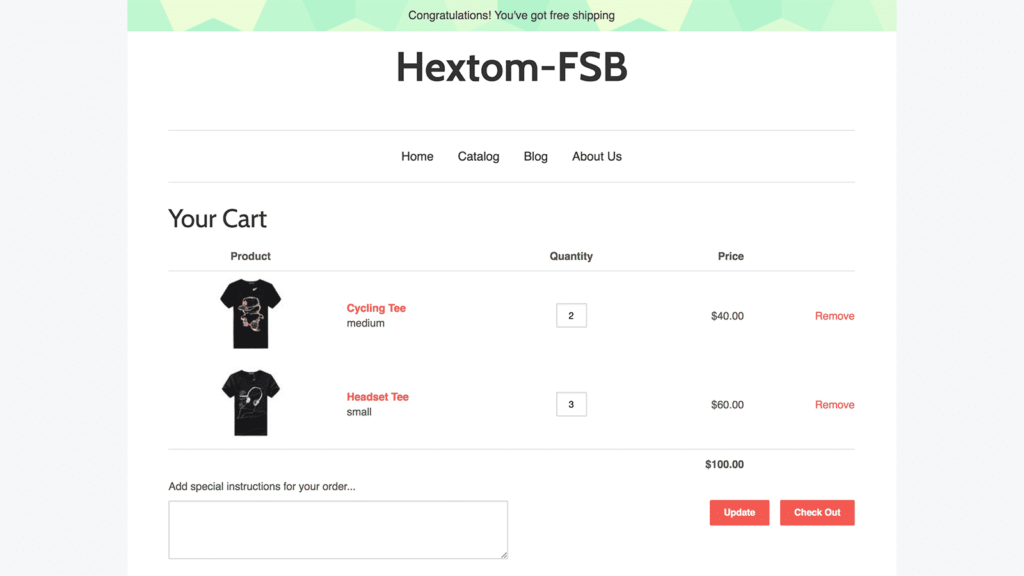
Source: Shopify App Store Free Shipping Bar
2. User-Friendly Shipping Software
As a business owner, giving up control and outsourcing to other companies is tough. The best Shopify 3PLs know that, so they provide their customers with easy-to-use shipping software that provides proactive notifications and robust reporting on how they’re doing. If you can’t get real-time updates on your orders’ status, inventory levels, and shipping and order fulfillment costs, then you’re not working with a cutting-edge 3PL.
One key benefit of great 3PL shipping software is proactive notifications. Unfortunately, things go wrong all the time in the shipping logistics world. It can be as simple as an undeliverable address incorrectly input by the customer or as complex as a worldwide supply chain and shipping crisis. The best Shopify 3PLs don’t leave it up to you to identify order fulfillment problems. Their shipping software should alert you when a customer orders with an undeliverable address. You can immediately fix the issue before it turns into a late shipment, and you’ll keep the customer happy.
“I use Cahoot to process our shipping labels. Their auto label creation feature is a huge time saver. We are continuing to use Cahoot over our previous shipping label provider.”
~ Home and Garden Supply
Speak to a fulfillment expert
3. Achieve a 99% On-Time Order Fulfillment Rate
Reviews are the lifeblood of your ecommerce business, and a happy customer is a repeat customer. You can probably recall more than a few lost customers and poor reviews that were due to errors in the order fulfillment or shipping workflow that were not your fault.
The best Shopify 3PLs minimize these issues and have an on-time fulfillment rate of 99.9% or higher. Anything less signals a Shopify 3PL that isn’t built for the rigorous demands of modern ecommerce.
Top 3PLs designed for ecommerce order fulfillment also integrate technology like barcode scanning into their warehouses to eliminate errors. Simple but effective innovations like these stop issues before they happen, and they also fuel the functionality of the software mentioned above.
4. Multi-Carrier Shipping Discounts and Carrier Flexibility
Shipping fees consume a significant chunk of every ecommerce merchant’s profits, but where there’s extra cost, there’s an opportunity to save. The best 3PLs who ship huge volumes of packages every year will negotiate preferred rates with major and regional parcel carriers, and they should pass those savings on to you.
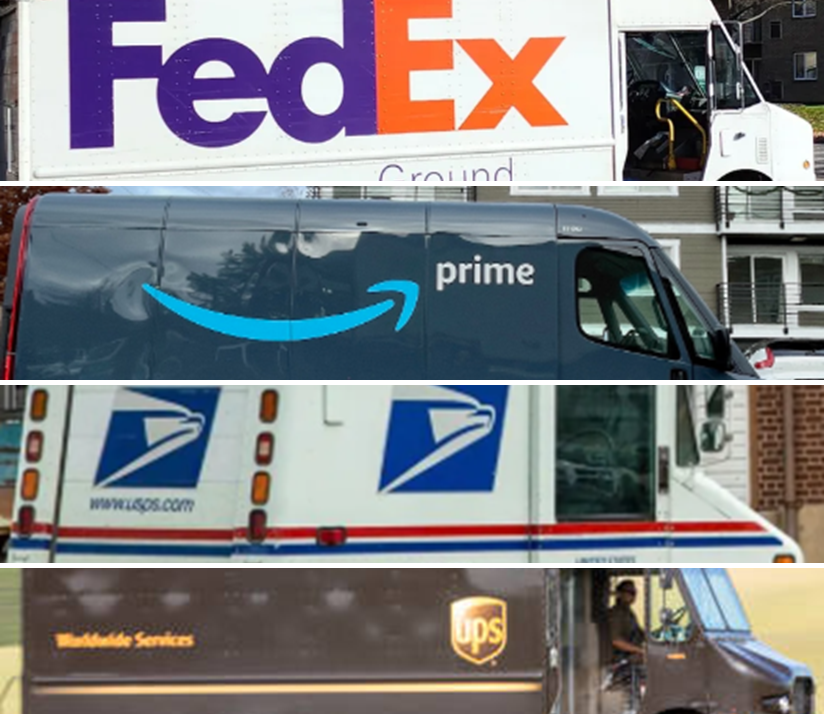
Beware though. A trick in the 3PL industry is to consolidate pricing into a single one-line item and not itemize what you’re paying for every component of their service. While it can feel helpful to be quoted one simple price, keep in mind this enables the 3PL to charge you more for shipping than what they’re paying the carrier and keep the difference without you knowing.
The best Shopify 3PLs work with all shipping carriers, not just one. The reason why is simple. Different carriers have the best rates for different routes, package sizes, and types of products. If you’re locked into just one carrier, you’re not getting the best shipping prices.
5. Pre-built Ecommerce Integrations and Open APIs
It shouldn’t be hard to connect your Shopify store to your 3PL. The best 3PLs have pre-built integrations that will do it in a few clicks (this goes for other ecommerce platforms, too). Many merchants are scaling into multiple sales channels to maximize growth, and your 3PL should be able to integrate easily with all of them.
Not every ecommerce merchant can work with pre-built integrations, especially larger ecommerce merchants with custom and complex order and inventory management systems. For that, your Shopify 3PL choice should have an open API and support resources that make the order fulfillment integration process as seamless as possible.
6. Responsive Customer Service
Finally, the best Shopify 3PLs offer amazing customer support. You should be able to get in touch with your 3PL easily to troubleshoot challenges. Look for a Shopify 3PL that assigns a real person to work with your ecommerce account. Make sure there are multiple ways to get in touch with them. If it’s a small issue, live chat works. Complex challenges should be handled by an advanced ticketing system. And finally, request direct phone support for critical or time-sensitive order fulfillment issues.
“We switched to Cahoot from a different 3PL and the team has bent over backwards to make the transition easy and seamless. Great personal assistance every day from the team and very quick, reliable shipping from the Cahoot partner warehouse. Highly recommend their service.”
~ Cut.com
Speak to a fulfillment expert
Top Shopify 3PL Companies
Now that you know what to look for, how do a few of the top players in the 3PL industry stack up? We’ve provided a primer to help jump-start your order fulfillment research.
Amazon Multi-Channel Fulfillment
Amazon Multi-Channel Fulfillment (MCF) is Amazon’s outsourced fulfillment service for merchants selling on non-Amazon sales channels whereby Amazon handles the picking, packing, and shipping of the orders coming from those sales channels. Ecommerce Sellers can store their inventory at Amazon’s warehouses, and MCF will fulfill the non-Amazon orders from select channels.
Shopify Fulfillment Network (Flexport)
Shopify Fulfillment Network (sold to and rebranded as Flexport in mid-2023 but still operating the Shopify Fulfillment Network app) is geared towards Shopify sellers. The pricing and shipping speed aren’t expected to be comparable to FBA as Shopify does not own any logistics infrastructure. This fulfillment option will work for you if you only need to fulfill orders in the United States, have fewer than 2,000 SKUs, ship more than 10 orders but less than 10,000 orders per day, and don’t sell any prohibited or regulated products.
ShipBob
ShipBob is a 3PL that focuses on serving ecommerce merchants. They have a nationwide network of order fulfillment centers that enable fast shipping, but they charge extra for guaranteed 2-day shipping. Built for ecommerce, they have an easy-to-use shipping software platform and a large set of pre-built integrations.
Red Stag Fulfillment
Red Stag Fulfillment is a more traditional 3PL with only two locations in the United States. They offer B2B fulfillment in addition to B2C since they have a wider focus than just ecommerce.
Cahoot: Shopify’s Premier Fulfillment Network
Cahoot’s order fulfillment services network is built for ecommerce. We’ll help you level the playing field and delight your customers with a stellar, Amazon Prime-like delivery experience for your Shopify store. And we don’t stop there. We have pre-built ecommerce integrations with major marketplaces to fuel your multi-channel growth. Don’t see one that you need? Let’s talk.
Our innovative peer-to-peer model offers low-cost, fast, nationwide order fulfillment by design. As a result, our pricing is typically 30% lower than the 3PL providers listed above, and we can beat them on order fulfillment speed and delivery reliability.
|
|
 |
Traditional 3PL |
|---|---|---|
|
Same-day fulfillment until 2pm |
|
|
|
Nationwide 1-day & 2-day coverage |
|
|
|
Weekend fulfillment |
|
|
|
Powerful, easy-to-use software |
|
|
|
Flexible fulfillment |
|
|
|
Real-time fulfillment & shipping visibility |
|
|
|
All sales channels |
|
|
|
Seller Fulfilled Prime (SPF) |
|
|
|
Fast-shipping badges – Walmart, Amazon |
|
|
|
30% avg. lower cost |
|
|
Cahoot is committed to helping Shopify Sellers grow their businesses with fast and affordable ecommerce order fulfillment service.
Looking for a New 3PL? Start with this Free RFP Template
Cut weeks off your selection process. Avoid pitfalls. Get the only 3PL RFP checklist built for ecommerce brands, absolutely free.
Get My Free 3PL RFPWhen is the best time to work with a 3PL?
The best time to work with a 3PL depends on your business’s specific needs and growth stage. It might be time to consider outsourcing fulfillment when you’re starting to run out of capacity. For example, if order volume consistently exceeds what you can handle efficiently in-house, or if your available storage space reaches or exceeds 75-90% of your capacity. Businesses that experience seasonal spikes in demand can benefit from a 3PL’s ability to seamlessly scale operations up or down as needed.
When logistics management becomes too time-consuming, or rising shipping costs are creating excessive margin pressure, outsourcing fulfillment allows you to focus on growing your business and improving your products while leveraging a 3PL’s carrier network and negotiated rates.
If you’re struggling to meet your on-time delivery promises or you’re dealing with frequent fulfillment errors and the customer service burden has gotten to be too much, it would be worth looking into a 3PL’s expertise and infrastructure; in particular, look into 3PLs that can support nationwide inventory distribution to reduce shipping times and costs.
Merchants looking to get smarter and more efficient with inventory forecasting so they can procure the right amount of inventory at the right time should partner with 3PLs that offer AI-driven intelligent demand planning software. Agentic AI is able to analyze fluctuations in market demand, freight forwarding trends, trade and policy current events, etc., and automatically create purchase orders with your suppliers (in their language), optimizing the amount of capital tied up in inventory.
If you’d like to find out how Cahoot can enhance your efficiency, reduce your costs, and support the growth of your ecommerce business, please get in touch with us. We can’t wait to show you how Shopify order fulfillment was meant to be.

If you are selling on multiple sales channels and are interested in a 3PL that can help you with fulfillment, check out some of our other articles:
- How to Choose the Best 3PL for Wayfair
- How to Choose the Best 3PL for Your Macy’s Orders
- How to Choose the Best 3PL for Target Plus
- How to Choose the Best 3PL for the Nordstrom Direct Drop Ship Program
Frequently Asked Questions
Can Amazon fulfill Shopify orders?
Yes, Amazon can fulfill Shopify orders using the Multi-Channel Fulfillment (MCF) service. MCF integrates a Shopify website with Amazon’s fulfillment network to pick, pack, and ship orders using the Fulfilled by Amazon (FBA) infrastructure and resources.
Does Shopify offer fulfillment?
Yes, Shopify owned and operated the Shopify Fulfillment Network (SFN, formerly known as Deliverr), before it was sold to Flexport in mid-2023. Shopify promotes Flexport as its trusted fulfillment partner.
How much does Shopify fulfillment cost?
Enter your product information into the Flexport Cost Calculator to see what you would pay with Flexport Fulfillment.
What does order fulfilled mean on Shopify?
When you fulfill an order in Shopify, you begin the process of sending the order on its way to the customer. The customer receives an email telling them that their item has shipped, and the order’s Fulfillment Status displays as Fulfilled on the Orders page.
What is fulfillment on Shopify?
Shopify Fulfillment Network connects your online store with Flexport, a leading logistics partner that will pack, pick, and ship online orders to your customers without any intervention.

Turn Returns Into New Revenue

3PL Fulfillment Pricing Comparison: Ecommerce Order Fulfillment: Peer-to-Peer Network vs Traditional 3PL
In the era of online marketplaces, most eCommerce merchants and brands find themselves at the mercy of order fulfillment solutions operated by the powerful corporations who act as gatekeepers for these platforms – for example, Fulfillment By Amazon and Walmart Fulfillment Services. Each platform requires merchants to send inventory to their warehouses and follow their unique policies and requirements. All of them also come with their respective fees and surcharges.
Sellers seeking a better deal have often turned to Third Party Logistics Providers (3PLs). They do so with the ambition of not just regaining control and autonomy over their logistics, but also boosting their profits. Fulfillment companies often adjust their pricing models based on order volume, storage, and shipping factors, which can include volume discounts, providing additional savings to the seller.
The problem, however, is that the vast majority of 3PLs operate from an extremely limited number of locations – hampering the seller from being able to offer customers the free, fast shipping experience that they now expect and demand. To solve this problem, a disruptive, radically different strategy is needed – a peer-to-peer order fulfillment network.
While merchants have worked with traditional 3PLs, a peer-to-peer network is an entirely new idea. Those merchants who have used traditional 3PLs are often unaware of their pros and cons. Far fewer are aware of how they compare to a peer-to-peer network. In this article, we take a deep dive, looking at every factor that influences a seller’s choice of fulfillment partner, and compare traditional 3PLs to peer-to-peer networks on each of them. We highlight how a Peer-to-Peer network can offer significant advantages compared to working with legacy 3PLs.
Cost
Traditional 3PL Fulfillment Services – What Do They Have in Common With Traditional Hotels?
Think of a time when you stayed at a boutique, traditional hotel – are you struggling to find or remember when you last did that? In the era of Airbnb, these single-location hotels have lost significant market share.
Why is that?
The reason is not competition – that there is a segment of travelers looking for a more economical, boutique experience compared to staying at a large hotel chain like Marriott or Hilton. The reason is that these traditional hotels are asset-heavy businesses that have no economies of scale. Because they primarily operate from a single location that they rent or own, they are significantly prone to cost pressures driven by land availability, rental rates, and staffing.
All this has meant that a marketplace model with a vast network, such as Airbnb (almost anyone can rent out a space), offers significant advantages to travelers that traditional hotels cannot hope to match.
What if we told you a traditional 3PL is exactly like these hotels?

A traditional 3PL usually operates from an extremely limited number of locations (2-3 at the most). This provides them with little to no economies of scale. They are also asset-heavy businesses that rent or own their properties. This is compounded by the fact that staff in the warehouse now expect to be paid $19 / hr. With multiple players, such as Walmart and Target, setting up fulfillment centers to deliver their eCommerce orders, traditional 3PLs must pay people more if they are to staff their warehouses. This is also a cost pressure that has to be ultimately absorbed by the merchants who work with them.
Additionally, the surge in e-commerce has significantly increased warehousing costs. The demand for warehouse space and labor has skyrocketed, leading to higher prices and intensified competition within the third-party logistics industry. Traditional 3PLs are particularly affected by these rising warehousing costs, which further strain their ability to offer competitive pricing.
Peer-to-Peer – What do Cahoot and Airbnb Have in Common?
Airbnb’s business model is asset-light – their idea is simple but powerful – anyone that has a spare room at their house that they don’t use can monetize it.
This two-sided marketplace model generates network effects, with millions of customers (property owners and travelers) interacting to ensure the platform offers competitive prices constantly. We have a similar idea for the future of eCommerce – rather than everyone building more warehouses as part of their own private, isolated networks, what if we optimized what’s already available?
Cahoot’s peer-to-peer network aims to unlock the potential of over 2 million retailers with their own warehouses. Any merchant with excess capacity in their warehouses can monetize it by becoming a fulfillment partner for Cahoot.
Our two-sided marketplace model generates network effects, with numerous businesses (sellers and fulfillment partners) interacting to drive prices downward. Just like Airbnb has a massive spread of listings, our model provides us with a vast network of strategically located warehouses across the country. And just like them, we’re more economical than the previous solutions customers used.
Slash Your Fulfillment Costs by Up to 30%
Cut shipping expenses by 30% and boost profit with Cahoot's AI-optimized fulfillment services and modern tech —no overheads and no humans required!
I'm Interested in Saving Time and MoneyQuality
Traditional 3PL – “Fast Shipping or Low Shipping Costs? Pick One”
With the limited number of locations these traditional 3PLs operate from, it becomes near impossible for them to cover the country through economical ground shipping in under two days.
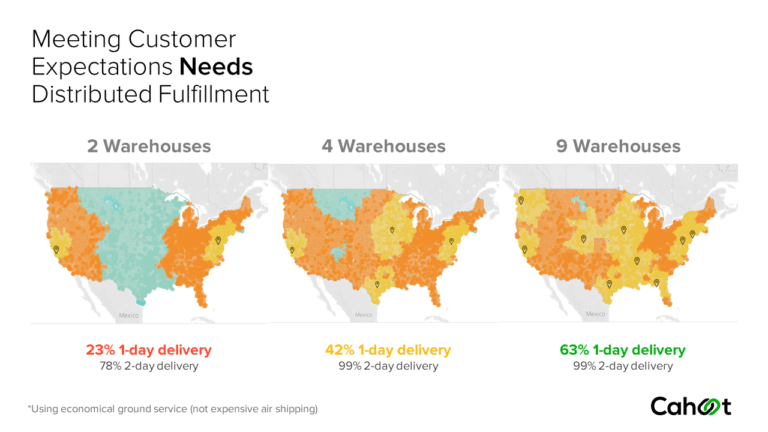
Based on our research, inventory needs to be spread across at least 4 strategic locations if a merchant is aiming for 2-day delivery to the entire contiguous United States (the lower 48 states). If the brand aims for 1-day delivery, it requires nine strategic locations.
When we talk about ‘strategic’ location, we mean it – a location is only strategic if it is located near a major population center. Suppose you’re a brand in the Midwest. In that case, it makes no sense to get excited about saving costs on inbounds by working with a traditional 3PL in Chicago, IL, when most of your orders might be coming from Southern California! Great candidates for strategic locations include New York, Chicago, and Southern California, as examples.
Most traditional 3PLs do not have warehouses at strategic locations – forcing their customers to decide whether to use economic ground services (but not meet the customer expectation for fast delivery) or incur extremely high costs by providing fast delivery through air shipping.
Peer-to-Peer – “Fast Shipping and Low Shipping Costs – Get Them Both.”
A Peer-to-Peer Fulfillment Network has a vast network of strategically located warehouses nationwide. With such a network, it is possible to cover the entire country through ground shipping in under two days. This makes it possible to meet the customer’s expectation for fast shipping while using economical services.
Many sellers might face hefty fees with platform-specific fulfillment services, such as Fulfillment By Amazon (FBA) for Amazon and Walmart Fulfillment Services (WFS) for Walmart. Merchants have no viable alternative because the only way traditional 3PLs can hope to offer the delivery speeds customers are used to is by using expensive air shipping. As no seller is willing to take a margin hit that deep, they are stuck with fulfillment services run by the marketplaces themselves.
With a Peer-to-Peer network, you do not have to make an either-or decision – you get the best of both worlds – providing both your business and your customers with benefits. Our network offers cost savings that boost your bottom line while also improving the experience your customers have.
Service Levels
Traditional 3PLs – Struggle to Offer The Bare Minimum
Traditional 3PLs just about get the basics done (with a lot of huffing and puffing and seller pain) – receiving your inbounds, picking, packing, and shipping your orders out the door on time. If you’re trying to handle additional requirements – such as operating the warehouse, arranging for carrier pickups, or fulfilling orders on the weekends, you’re likely out of luck.
The problem is that these ‘additional’ requirements are now becoming table stakes as this is what programs like Amazon Seller Fulfilled Prime expect. Additionally, customers expect their orders faster and faster, meaning that doing the basics alone may no longer be enough even to stay afloat.
Those aiming to compete with Amazon, including large retailers like Walmart, are realizing they must offer customers Prime-like experiences. Walmart’s shipping standards are also challenging – products with 2 and 3 day delivery speeds are ranked higher in search results, win the buy box more often, and see higher conversion rates. Sellers are also expected to ensure that they deliver 95% or more of orders within the promised time to customers.
Many of these 3PLs may also be unable to offer late cut-off times. Late cut-off times allow for carrier pickups and scans to occur the same day, meaning more of your customers will receive their orders in 1 or 2 days.
Perhaps most worryingly of all, customer support can often be erratic, unreliable, or slow to respond. Shipping and order fulfillment is a crucial part of your business operations. Lengthy resolution items can mean significant outages and downtime for your company.
Peer-to-Peer – Meet and Exceed the Gold Standard for Order Fulfillment
With Cahoot’s peer-to-peer network, you don’t just have to settle for the basics. We help sellers on Amazon meet and surpass the demanding criteria of the Seller Fulfilled Prime (SFP) program. The SFP program’s requirements are arguably the most challenging in the industry. Any merchant who can meet and surpass them has an excellent order fulfillment strategy in place.
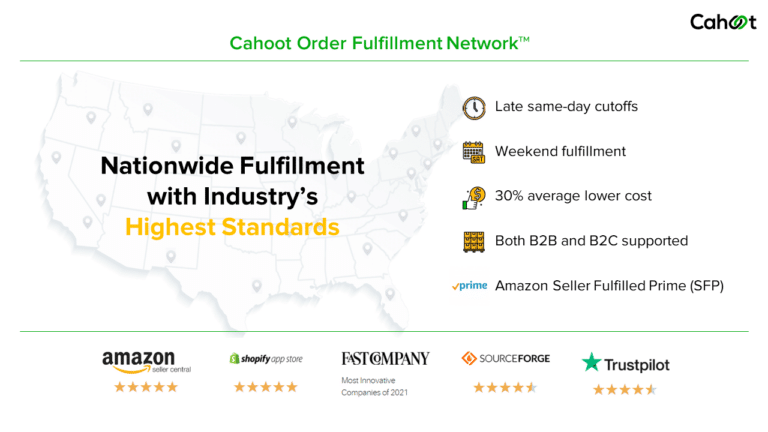
We support warehouse operations, carrier pickups, and delivery on the weekends. We also offer late cut-off times, ensuring that you can increase the proportion of customers whom you service with 1- and 2-day delivery.
Our US-based customer support team is also ready and responsive to any of your questions. We know that eCommerce order fulfillment is complex, and things don’t always go as planned. What’s crucial is ensuring that those issues are addressed quickly, getting your business back on track. With our team, you can count on minimum downtime.
Technology
Traditional 3PL Fulfillment Providers Try to Handle Fulfillment Without Tailormade Tools
Many traditional 3PLs solve just one piece of the problem – the task of order fulfillment itself. Most of them fail to provide customers or their employees with the shipping software technology needed to speed up order fulfillment at scale.
The technology that most traditional 3PLs deploy is not much more advanced than what a micro-shipper fulfilling their orders on their own might be using.
Even if traditional 3PLs deploy technology, it tends to be legacy software, like ShipStation. Such tools require constant human intervention and oversight. For example, for every single customer order that is received, a tool like ShipStation requires staff to compare rates across different fulfillment locations and carrier services, manually identifying the cheapest option to pick.
Such systems mean that an enormous amount of time is wasted every single day by employees simply rate-shopping for shipping labels when they could be engaged in higher-order work.
For other workflows like keeping track of inventory, traditional 3PLs deploy similarly clunky, inflexible software incapable of meeting today’s needs. This runs the risk of accepting customer orders on SKUs that are out of stock, leading to canceled orders and unhappy customers. Unfortunately, your customers aren’t going to blame your 3PL’s poor technology when there are issues with their deliveries – they’re going to point the finger at you.
Peer-To-Peer – Scale Order Fulfillment with Purpose-Built Software
While our peer-to-peer network provides nationwide coverage, our next-generation shipping software supercharges productivity and accelerates order fulfillment.
For every order received, Cahoot’s software can intelligently compare multiple warehouse locations and shipping services, instantly determining the most economical shipping label that meets customer delivery promises.
Our software is designed and purpose-built from the ground up to excel at scale. When your order volumes surge, manually printing shipping labels can be a massive source of inefficiency. With Cahoot, all your shipping labels are ready to print in one click – dramatically speeding up fulfillment and freeing up staff to concentrate on higher-order work.
Our technology comes with other intelligent features – such as optimizing packaging choices for Multi-Line, Multi-Quantity (MLMQ) orders, as well as intelligently keeping track of inventory decrements. Color-coded alerts on our dashboard provide merchants with real-time visibility into dipping inventory levels. This allows for proactive decision making to accelerate sales, rather than scrambling to react too late.
Redundancy and Backup
Traditional 3PL – Highly Vulnerable to Single Point Failures
eCommerce order fulfillment is not an easy thing, and there are potentially many things that can go wrong – such as 3PL delays with receiving your inventory, damages to inventory in transit, misplaced inventory, or carrier errors.
There are also things for which it is difficult to account for – such as unexpected, extreme weather events that disrupt carrier operations.
While you can strategize to minimize or avoid some issues, others are simply out of your control. Unfortunately, this is where a traditional 3PL is highly vulnerable. When you operate from a single location, an outage in that location can be catastrophic. Your entire order fulfillment operations come to a grinding halt, putting your sales on pause. Worse, customer complaints will surge, resulting in lots of negative reviews and refund requests.
Customers today may not be forgiving even of circumstances outside your control, such as weather events – they ask a pertinent question, “Why weren’t you prepared with an alternative strategy?”
One minor issue at your 3PL can quickly snowball into a disaster for your brand reputation and customer loyalty. The only option sellers have is to find fulfillment partners whose solutions come with excellent risk mitigation, ensuring that orders reach customers no matter what.
Peer-To-Peer – Always Lights On For Your Business
A network of warehouses in different locations ensures that you’re inherently much more likely to keep your business operations constantly running smoothly.
You’re de-risked on multiple dimensions – if there’s terrible weather in 1 location, you can still fulfill orders from another warehouse. If there are issues with a carrier over there, you can ship from another location. If there’s an outage there….you get the idea.
This ensures that you’re constantly selling and customers are constantly getting their orders. They may also really appreciate how your business is always ready to serve them, no matter the circumstances. Unexpected, adverse circumstances don’t result in angry customers and negative reviews when working with Peer-to-peer fulfillment networks, they’re just another opportunity to continue selling and keep providing your customers a great experience.
Looking for a New 3PL? Start with this Free RFP Template
Cut weeks off your selection process. Avoid pitfalls. Get the only 3PL RFP checklist built for ecommerce brands, absolutely free.
Get My Free 3PL RFPScalability
Traditional 3PL – Works Initially, But Stumbles at Scale
Going back to our earlier example, let’s say you’re a brand starting out in the Midwest, and you found a great traditional 3PL in Chicago, IL. You’re thrilled because your geographical proximity to them means that you’ll be saving a lot on inbound freight costs (sending your inventory to their warehouse on a truck).
In your first few days, most of your customers are your friends, who spread the word about your brand to their circles. Most of your orders tend to come from the Chicago area and Michigan – things are working well with the traditional 3PL. You can service your customers with fast delivery while using economical ground shipping.
At some point, your brand surges in popularity, and you start receiving orders nationwide – you’re thrilled and can already imagine the cash registers ringing! However, after an initial surge, you soon see very few orders coming in. After doing some investigation, you discover that your 3PL’s inefficiencies are costing you – customers in Southern California are receiving their orders far too slowly. Worst of all, knock-off listings on the Amazon marketplace have seized on your idea, and are now winning against you because they’re offering customers faster shipping. You also see a surge of refund requests, from customers who are unhappy with the time it’s taking for their orders to arrive.
Traditional 3PLs are ill-equipped to deal with spikes in order volume that happen naturally as you scale. These companies don’t become an enabler of your growth; they can be just the opposite – a bottleneck that slows you down.
The problems with traditional 3PLs mount at the worst possible time – once you start seeing orders come in from Southern California, let’s say you identify another fulfillment partner in Los Angeles. Now you have two contracts, each with its own pricing structure. There are 2 different SLAs for order fulfillment and you have to pick which location each of your orders is routed to, all on your own. Managing these two 3PLs can completely consume your bandwidth, overtaking your focus on the activities that actually matter – selling and taking care of your customers.
Other problems emerge as you scale – let’s say you’ve somehow figured things out, and have made DTC fulfillment work with these two traditional 3PLs. As you grow further, you start sending pallets to retailers all over the US, such as Target, Nordstrom, or Macy’s. Suddenly, your 3PL has no space for your containers and struggles to handle B2B fulfillment. Additionally, many of these traditional 3PLs may lack the EDI technology which is a prerequisite to work with many retailers and brands.
Peer-to-Peer – Accelerates Growth By Scaling Alongside You
Let’s imagine you’re the Midwest brand again. This time, you’re working with Cahoot’s peer-to-peer network. When you start out, you ship orders from one of our Midwest fulfillment centers, providing customers with free, fast shipping.
When your brand surges in popularity, things don’t fall apart – you simply add more nodes on the Cahoot network to fulfill orders from. You use our fulfillment centers in Southern California to ensure you deliver a high-quality experience to your customers on the West Coast.
You also work only with 1 vendor, offering you 1 contract. This ensures you can scale nationwide fulfillment, with none of the process management overhead that working with traditional 3PLs brings.
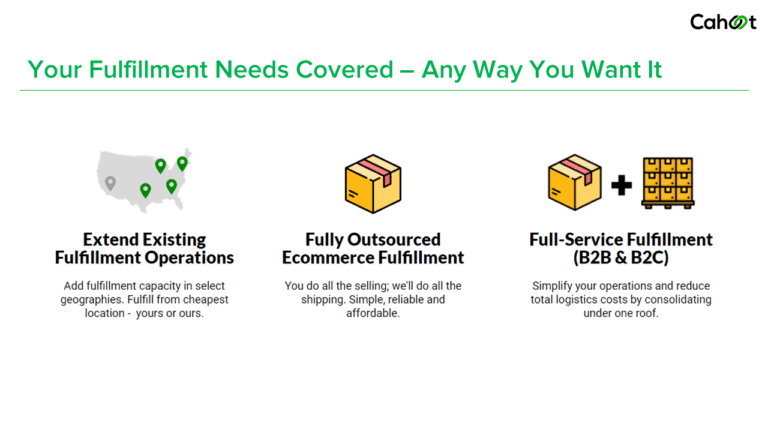
We also have experience and expertise in handling B2B fulfillment, in addition to DTC fulfillment. Whatever the spike in order volume you see, we’ll make sure that you actually celebrate your success. You won’t be spending your time thinking, “Can our fulfillment keep up with all this growth?”
Traditional 3PL – Great for Regional Shipping
Traditional 3PLs do a reasonably good job of servicing the specific parts of the country that they are located in. For example, a traditional 3PL on the West Coast might be great for orders in all states in that part of the country.
Because of the restrictions on the number of locations they have, these 3PLs find offering nationwide coverage at affordable rates extremely difficult.
While these models may work for brands with a strongly regional customer base, the problem is that nearly every seller dreams of scaling nationally and globally at some point – these 3PLs can often become a hindrance when the sellers do decide to start expanding.
Peer-to-Peer – Great For National Programs Like Amazon SFP
Previously, Amazon’s Seller Fulfilled Prime (SFP) program had a regional component – brands could fulfill orders just in their region of the country on their own while still featuring the Prime badge on their product listings on the Amazon marketplace. However, Amazon now expects fast shipping across the entire contiguous U.S. on the program – products across every size category must be delivered in 3-5 days, while approximately 70% of orders on standard-sized products must be delivered in 2 days or less.
Traditional 3PLs will find it nearly impossible to meet this requirement using ground shipping because of their location constraints. Using air shipping is not an option for sellers in most cases because that erodes any cost savings they were hoping to see over FBA.
Analytics and Reporting
Traditional 3PLs – Decisions Made on Instinct
Traditional 3PLs tend to make most decisions using a combination of intuition and guessing. Some of the most crucial pieces of the eCommerce order fulfillment workflow are – Which warehouse to dispatch an order from, and which box to pack the items in?
Most traditional 3PLs do not have the purpose-built technology needed to determine the warehouse each order should be sent from. At best, a rudimentary heuristic based on the customer’s ZIP code might be deployed. The problem is that you could be losing money on every shipment. Until you invest in the right technology, you’ll never actually know the full extent of your losses.
The second crucial factor is the choice of box to use. Traditional 3PLs have a limited number of boxes of the most popular sizes. They randomly throw products into any box that fits. In the best case, an ad-hoc heuristic might be defined to map each SKU to a box, by eyeballing the box and product sizes. This creates problems on multiple dimensions. The first is that the overall cost of packaging materials continued to increase at a pace faster than inflation, while the cost of paper and cardboard increased by as much as 9% in 2024. This means that if you’re selecting larger sized boxes on each order, your costs surge. More crucially, the shipping carriers set their prices in tiers, based on the dimensional weight of items. This means that the wrong choice of box for a lightweight item can tip it over into a higher pricing tier than is actually needed. Sellers can bleed money on both avenues – cost of supplies, and the fees they pay to the shipping carriers. Today, there is also a growing consumer demand for environmentally responsible, sustainable packaging. When items reach environmentally conscious consumers in oversized boxes, it can negatively impact the experience they have with your brand.
Lastly, most traditional 3PLs do not offer enough variety of warehouse locations to actually place your inventory close to where most of your customers live – even in cases where they have multiple warehouse locations, they could still place your products in the wrong fulfillment center!
The only way to eliminate ambiguity and make the optimal selection each time is to ensure decisions are guided by past data and real-time technology automation – unfortunately, most 3PLs do not offer that.
Peer-to-Peer – Decisions Informed by Data
With Cahoot’s Peer-to-peer network, we let data and technology make the most critical decisions.

For order routing, our next-generation software intelligently compares multiple warehouse locations, carriers and shipping services before picking the most optimal location and service that can meet the delivery promise committed to the customer.
We use advanced 3D bin technology to evaluate the fit of items in boxes, ensuring that each SKU goes into the best-sized box. Our software also comes with intelligent automation for Multi-Line, Multi-Quantity (MLMQ) orders, where our system learns from box and SKU dimensions, as well as past packaging choices to optimize box selection.
Lastly, while warehouses on our network are located near major population centers, it still means nothing if we don’t place your inventory in the location closest to where most of your customers live. We go deep and sweat the details to identify geographic trends in your historical orders, ensuring that we set you up to see maximum savings.
Flexibility and Agility
Traditional 3PL – High Switching Costs, Hidden Fees, Painful Migration
Traditional 3PLs often do not operate with flexible, merchant-centric models where you can build from what you have. Like we mentioned earlier, each of them comes with limited geographic coverage of the country, and offers their own pricing contract and SLA.
Let’s say you’re working with a traditional 3PL that gives you coverage on the East Coast. While their services are good, you’re trying to find out if there’s a way for you to expand to the West Coast. Traditional 3PLs do well when they have as much of your inventory tied to their warehouses as possible. You may be hit by high fees on both fronts – the removal fees from the East Coast 3PL, and the inbound fees with the West Coast provider.
Worst of all, once you do manage to migrate your inventory over, you’ll still have to deal with the process management overhead that comes from working with two fulfillment partners.
While this does not sound like an easy process, we’ve put together a step-by-step guide on how to migrate from one fulfillment partner to another.
Peer-to-Peer – Seamless, Painless Migration
A Peer-to-Peer Network is the most merchant-centric, merchant-inclusive platform for Order Fulfillment. Cahoot’s Peer-to-Peer network is not a ‘winner takes all’ arrangement. We’re not only an option for merchants looking for ultrafast eCommerce order fulfillment, but also an option for 3PLs looking to serve their customers better.
When our customers are happy with using their existing 3PL to serve a particular part of the country, say the West Coast, we can flexibly scale nationwide coverage on top of their current setup. They can bring their 3PL to our network, where we provide them with an economical way to cover the East Coast.
In fact, one of the biggest features of the peer-to-peer model is that it can be a way through which traditional 3PLs can overcome their geographical constraints while helping merchants achieve free, fast nationwide shipping.
Integration and Consistency
Traditional 3PL – Extremely Fragmented, Increased Overhead
Many traditional 3PLs were designed for the older, pre-Amazon Prime era of eCommerce when merchants fulfilled orders from just one or two channels. In today’s world of online marketplaces, traditional 3PLs may not support all of the different marketplaces. You may have to work with one 3PL for your Walmart orders, while handling Shopify fulfillment through another. The depth of integration also matters – for example, does the technology these 3PLs use transmit inventory count information back to the sales channel so that you avoid receiving orders on out-of-stock items? Can they transmit tracking information back to the channel? And does your order fulfillment help you meet the unique expectations customers have on each marketplace?
As you work with multiple 3PLs, your ability to offer consistent order fulfillment may be severely compromised. With these providers, handling the basics of order fulfillment becomes challenging. When it comes to exception management on specific orders, the problem worsens.
Let’s imagine you’re working with warehouses from two 3PLs, each with their own SLA – the first has a cutoff time of 1PM, the second 12PM. Suppose an order comes in at 12 30 PM – but there’s been an unexpected issue with the first warehouse. You’re unable to reroute the order to the second warehouse because it’s already past the cutoff time there. The problem stems from the fact that each warehouse has its own SLA and none of them are integrated to each other.
If you’re seeking to expand sales channels or achieve nationwide coverage, the number of such fragmented, siloed warehouse nodes increases exponentially – drowning you and your team in process management. You may need to hire dedicated people to babysit and oversee this operation, which negatively hits your costs.
Peer-to-Peer – Unified, Simple and Consistent Across Every Channel
With a Peer-to-peer fulfillment network, you get custom-built, out-of-the-box integrations for all major marketplaces. We pull all the critical information about orders and their delivery due dates into our system, while pushing back updated inventory and carrier tracking information to the respective channel. This extends to our fulfillment operations – we ensure that you stay compliant with the unique requirements that each marketplace has, such as usage of a particular shipping carrier / service, or branded packing slips.
With Cahoot, you spread your inventory across multiple warehouses, but work with just one partner. This ensures that you can offer a consistent experience on every order. This solid foundation makes exception management much easier to handle. When orders may not make it in time because of issues at one node, we can intelligently reroute it from another location with minimal overhead. We also offer consistent SLAs and every node on the network is tightly connected.
With a Peer-to-peer fulfillment network, the number of warehouses and sales channels increases, but there’s always only minimal process management needed. You and your team will get back more time to focus on growing the business.
Environmental Sustainability
Traditional 3PLs – Excess Packaging Waste and Greenhouse Gas Emissions
Customers today expect brands to be sustainable and environmentally responsible in their operations. A traditional 3PL exacerbates problems for brands across 2 different dimensions, packaging, and emissions.
Traditional 3PLs tend to have a random, haphazard approach to packaging – they have a few boxes of the most popular sizes, and the warehouse staff simply place the item into whichever one might be available on hand.
When the customer receives the order, they might be annoyed that their item was delivered in an overly large box, generating more waste for the environment. For environmentally-conscious shoppers, such experiences can ruin their relationship with the brand, completely turning them off from future purchases.
A bigger problem can arise because of the limited number of warehouse locations. Due to this, they’re forced to use air shipments or keep packages in transit for longer on the road. All this increases emissions released, worsening your brand’s carbon footprint and weakening your sustainability credentials.
Peer-to-Peer – Eliminate Packaging Waste and Slash Emissions
While our network of strategically located warehouses, you’ll nearly never use air shipping (unless customers specifically ask for it). You’ll be able to offer fast and economical ground shipping – which is great for your customers and the environment. But we go a step further and help you cut down packaging waste also.
As we mentioned before, our software’s 3D Bin Technology and its Multi-Line, Multi-Quantity Automation features help ensure you always use only the necessary amount of packaging material.
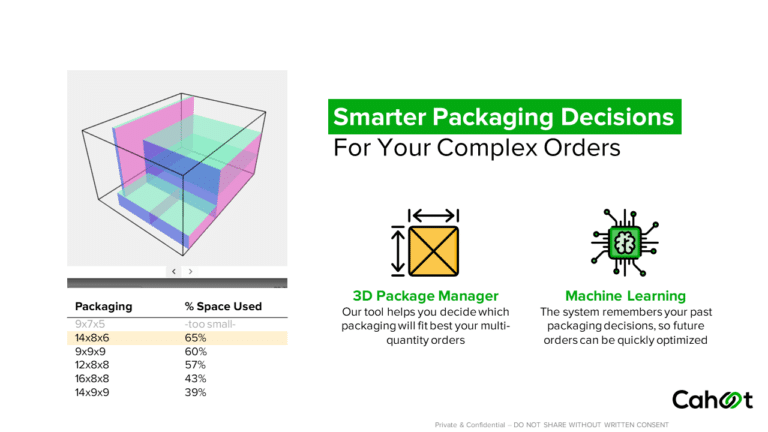
Lastly, environmental sustainability is the core cause that a peer-to-peer network is fighting for – in a world where everyone is using up more resources to build logistics infrastructure for their own private network, we’re aiming to use the Power of Many to build a more sustainable fulfillment network, without compromising on today’s sky-high customer expectations.
Reliability
Traditional 3PL – Fail to Live up to Their Promises
Most people tend to choose a traditional 3PL because they think a company dedicated to logistics and shipping can do a better job than a fellow merchant fulfilling your orders for you.
However, as we’ve discussed in the sections above, we think traditional 3PLs are still operating to serve the old paradigm of eCommerce. While you may feel that you are ‘in safe hands’ initially, the reality may be very different and disappointing.
Most traditional 3PLs may promise a lot, but struggle to deliver even the basics. Where does this disconnect come from? Most sellers are extremely busy and cannot afford to spend endless hours vetting their 3PL’s performance and services. Decisions may be taken with limited information and time – unfortunately, this leads to a lot of unpleasant surprises after the inventory has been received and orders start flowing in.
It’s worth asking – how can merchants rigorously vet their 3PLs to make sure their claims are actually true? With Cahoot, you won’t have to worry about that – because we’ve already taken care of that.
Peer-to-Peer – Only The Best Warehouses Pass Cahoot’s 44 Point Checklist
Some people think that working with a traditional 3PL (with their own warehouse space) is better than operating in a peer-to-peer network. Most people who feel this way share one concern, “How Can I Trust Another Merchant to Deliver My Orders?” A similar concern was shared by many people when Uber first rose to popularity, defeating the cabbies in London and New York’s famous Yellow Taxi. In London, people must spend 3 years training to be accepted as a cab driver. With Uber, nearly anyone could start driving taxis instantly. A similar sort of nervousness was prevalent among people, who asked, “How can we trust getting in a car with a stranger?” Interestingly, the data challenges the popular perception – according to research conducted at NYU, humans trust authentic sharing economy workers more than their neighbors and colleagues (and nearly as much as their families). The keyword in that sentence is authentic. Authenticity is built by high levels of trust and transparency – such as Uber drivers providing their details and a profile picture on the platform.
Similarly, we recognize that building authenticity is crucial. Order fulfillment is a crucial aspect of business operations, and you don’t want to be handing that task over to someone you can’t trust. We foster trust with our sellers by rigorously vetting fulfillment partners. Cahoot has a 44-point checklist that warehouses must pass if they are to become part of our eCommerce order fulfillment network. This ensures that only the best warehouses, with excellent packing practices and order fulfillment standards, make the cut. Cahoot also has zero tolerance for defects and regularly reviews the performance of its fulfillment partners. We think that a warehouse in the Cahoot network has been through more rigorous vetting than the review that the average seller does on a traditional 3PL. This means that there’s a good chance that a Cahoot warehouse is better than the one at your traditional 3PL. With our vetting and audits, you can rest assured that it’s a safe and trustworthy one, too.
Privacy and Security
Traditional 3PLs – Lax Data Security Measures
With traditional 3PLs, your customer information moves across multiple systems without proper safeguards. They might request for all your order and customer information to be transmitted to whatever technology they are using. If that is different from their shipping software, then your proprietary data enters another system outside your purview.
While you may have signed contracts with the 3PL, your data still rests on multiple systems that they operate, with minimum visibility. Worse, you are entirely reliant on their information security practices, which may be minimal or even non-existent.
In the era of Europe’s General Data Protection Regulation (GDPR) and the California Consumer Privacy Act (CCPA), no company can afford a data breach. Under a regulatory framework like GDPR, customers have the right to request for deletion of their data. If sensitive details like their name, phone number and address are already on systems that your 3PL controls, it increases exposure and risk to your business.
Peer-to-peer – Robust Data Privacy and Governance Measures
While having confidence in the order fulfillment standards of our warehouses is important, another concern sellers might have is, “How can we trust that other merchants will not see or use our customer data?” While Uber built high levels of trust in people, it still could not change the fact that people were indeed getting into a car with a stranger. To safeguard its customers and set their fears at ease, Uber has put in place various safety measures on its app. Some of these include GPS tracking, the ability to transmit location information to emergency services, logs of historical trips as well as the very famous rating system – where both riders and drivers review each other after each ride (a social incentive to behave respectfully).
With Cahoot’s peer-to-peer fulfillment network, you can sit back and relax knowing that every order will be fulfilled on time. However, we do know that another merchant is responsible for fulfilling your order, and take data privacy extremely seriously. We provide a single platform where you get total control and visibility into your data. When our fulfillment partner prints a label to ship your order, they see the customer’s first name, but only the initial of their surname. Only the absolute essential information needed for order fulfillment is shared with the fulfillment partner, while all other product / brand / customer information remains with the seller.
Scale Faster with the World’s First Peer-to-Peer Fulfillment Network
Tap into a nationwide network of high-performance partner warehouses — expand capacity, cut shipping costs, and reach customers 1–2 days faster.
Explore Fulfillment NetworkCommunity
Traditional 3PL – You Work With a Vendor
Working with a traditional 3PL is often nothing more than a transaction – you pay them a lot of money, and they perform the task of order fulfillment for you. While getting your orders out to customers is vital, there’s often little differentiated value addition that you get from the engagement.
Peer-to-Peer – Work With a Partner Reduce Costs and Generate Revenue
With Cahoot’s peer-to-peer network, you can have ultrafast eCommerce order fulfillment by partnering with us. But it doesn’t have to end there. If you have excess capacity in your own warehouse, you can actually double up as a Fulfillment Partner on the network to monetize that and bring in additional revenue. Order Fulfillment is a growth driver, not a cost center – with us, those words definitely ring true. This is similar to Uber drivers in their home city becoming riders when they’re traveling!
Summary
While traditional 3PL companies are useful for the things they do well, they have limitations that can put pressure on sellers trying to succeed in the rapidly changing environment of modern ecommerce. For sellers trying to achieve Prime delivery standards without using FBA, or those that simply require nationwide reach for their fast delivery options, a traditional 3PL on its own is not sufficient.
Cahoot’s innovative fulfillment network combines the benefits of a traditional 3PL, but adapted to the needs of a modern online merchant. Ambitious sellers can no longer afford to limit their fast delivery options to certain regions, and they must submit numerous fees and conditions to get the reach.
Whatever your needs, Cahoot can deliver differentiated value to your business. Reach out to us today to get started!

Turn Returns Into New Revenue




